

Rosh Hanikra Grottoes: Tourist Guide
Explore the breathtaking natural wonder of the Rosh Hanikra Grottoes with our comprehensive tourist guide. Discover the history, geology, and must-see attractions of this unique destination. Here, visitors can witness an awe-inspiring limestone sea cliff with amazing grottos carved into the rock.
Enjoy spectacular views of the Mediterranean Sea and explore this site’s unique geological formation, fascinating history, and plethora of activities. Read on for our comprehensive guide to Rosh Hanikra Grottoes – and get ready to explore one of the world’s most amazing sites!
Overview of the Rosh Hanikra Grottoes
The Rosh Hanikra Grottoes are a unique geological formation located on the Mediterranean coast of Israel, near the border with Lebanon. The grottoes are a series of caves and tunnels carved into the white limestone cliffs by the action of the sea over thousands of years.
Visitors can take a cable car or walk down to the grottoes and explore the caves on foot, where they can see stunning stalactites and stalagmites. The grottoes also offer breathtaking views of the Mediterranean Sea and the surrounding landscape. The Rosh Hanikra Grottoes are a popular tourist destination and a must-see for anyone visiting the area.
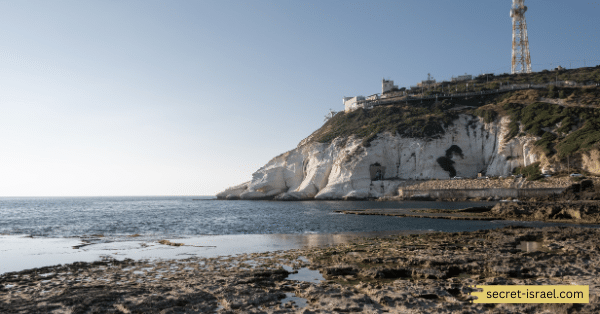
History and Geology of the Grottoes
The Rosh Hanikra Grottoes have a rich history and geology. The grottoes were formed over millions of years as the Mediterranean Sea pounded against the white limestone cliffs, carving out the caves and tunnels we see today. The grottoes have been known to mankind for thousands of years, with evidence of human habitation dating back to ancient times.
In more recent history, the grottoes were used as a strategic location during various conflicts, including the 1948 Arab-Israeli War and the 2006 Lebanon War. The grottoes were also used as a railway tunnel during the British Mandate period in Palestine.
Geologically, the Rosh Hanikra Grottoes are an excellent example of marine erosion, with the caves and tunnels being formed by the action of waves and the sea. The grottoes are made of white limestone, which is a type of rock that is easily dissolved by water. This process of dissolution creates unique and intricate shapes found in the grottoes, such as stalactites and stalagmites. The grottoes also have a unique feature called “curtains,” which are thin layers of rock that hang from the ceiling like curtains.
In summary, the Rosh Hanikra Grottoes are a unique and important destination for those interested in history, geology, and natural beauty. The grottoes are a result of millions of years of erosion and have played a role in human history for thousands of years.
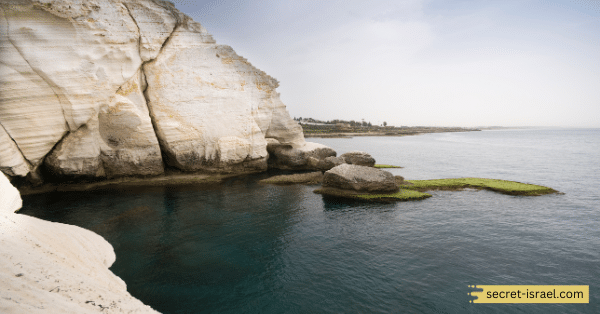
Accessing the Grottoes: Transportation and Tickets
Accessing the Rosh Hanikra Grottoes is relatively easy, and there are several transportation options available for visitors.
By car: The grottoes are located on the Mediterranean coast, and can be easily accessed by car via the Rosh Hanikra Road. There is a parking lot available for visitors.
By train: The grottoes can also be accessed by taking a train to the nearby Rosh Hanikra station. From there, it is a short walk to the grottoes.
By bus: Several bus routes stop at Rosh Hanikra, which is the nearest bus stop to the grottoes.
Once you arrive, visitors can take a cable car or walk down to the grottoes. The cable car ride is a unique experience in itself, as it offers a bird’s eye view of the grottoes and the surrounding landscape.
Address: Israel
Opening Hours:
- Friday 9 AM–4 PM
- Saturday – Thursday 9 AM–6 PM
Phone: +972 73-271-0100
Admission Fee: ₪ 43.08
Navigate here to see the location’s actual view.
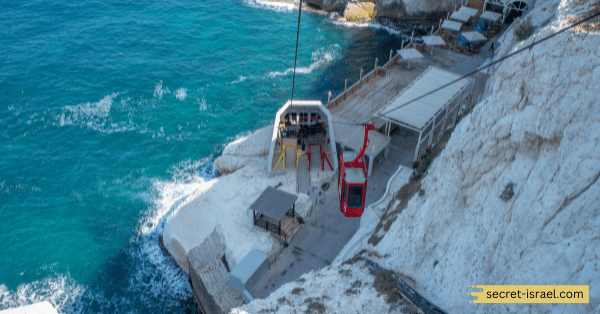
Activities and Attractions at the Rosh Hanikra Grottoes
The Rosh Hanikra Grottoes offer a wide range of activities and attractions for visitors to enjoy.
- Exploring the grottoes: Visitors can walk through the caves on foot and admire the stunning stalactites, stalagmites, and “curtains” that have been formed by the action of the sea over millions of years.
- Visiting the on-site museum: The museum provides information about the history and geology of the grottoes, and how they were formed.
- Taking a walk along the Mediterranean coast: Visitors can enjoy scenic views of the sea and the cliffs.
- Hiking: There are several hiking trails in the area, which offer panoramic views of the grottoes and the surrounding landscape.
- Rosh Hanikra light and sound show: An immersive experience that combines light and sound effects with the unique natural beauty of the grottoes, which takes place at nightfall.
- Water activities: Kayaking and boat trips along the coast are available for adventurous visitors.
- Cable car ride: Cable car offers a bird’s eye view of the grottoes and the surrounding landscape.
- Guided tours: Guided tours are an excellent way to learn about the history and geology of the grottoes and gain a deeper understanding of the natural wonder.
Tips for Visiting the Rosh Hanikra Grottoes
Visiting the Rosh Hanikra Grottoes can be a memorable experience, and here are some tips to make the most out of your visit:
- Plan your visit: Check the official website for information on opening hours, ticket prices, and other important details.
- Wear comfortable shoes: The grottoes can be slippery and uneven, and comfortable shoes are a must for exploring the caves on foot.
- Bring a flashlight: Although the grottoes are well-lit, a flashlight can come in handy for exploring some of the darker areas of the caves.
- Take a guided tour: Guided tours are an excellent way to learn about the history and geology of the grottoes and gain a deeper understanding of the natural wonder.
- Visit at different times of the day: The grottoes look different depending on the time of the day and visiting in the morning, afternoon, and evening can provide a different perspective and experience.
- Don’t forget your camera: The Rosh Hanikra Grottoes offer stunning natural beauty and incredible photo opportunities.
- Be aware of the weather conditions: The grottoes can be slippery and dangerous during rainy or wet conditions, so check the weather forecast and plan accordingly.
- Be prepared to walk: The grottoes are located at the bottom of the cliffs, and you need to walk down to reach them, so be prepared to walk.
In conclusion
The Rosh Hanikra Grottoes in Israel are a breathtaking natural wonder that offers visitors an unparalleled experience. The grottoes have been carved over millions of years by the action of seawater and feature unique geological formations such as stalactites and stalagmites. The grottoes also have a rich history and have been used for strategic purposes during various conflicts.
To make the most out of your visit, plan and be prepared to walk down to the grottoes. With its stunning natural beauty, rich history, and a multitude of activities available, the Rosh Hanikra Grottoes is a must-see destination for anyone visiting Israel.
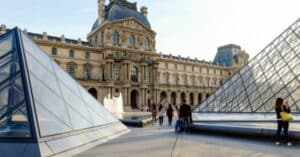
Europe’s charm lies not just in its stunning architecture and historical treasures but also in the myriad of adventures

Are you considering relocating to Jordan? This small yet vibrant middle-eastern country has a rich history and culture, making

Jordan is a country in the Middle East that has been making significant strides in the education sector. With

Jordan is a beautiful country in the Middle East, known for its ancient historical sites, diverse landscapes, and warm

Experience a dreamy elopement in Jordan, where ancient wonders meet modern romance. Exchange vows at Petra by Night, dive

Jordan offers a dreamy elopement paradise with its historic wonders, breathtaking landscapes, and vibrant cities. From the ancient splendor

Eloping in Jordan is a dream come true. With its safety, rich history, and natural beauty, it’s the ideal

Discover the unique marriage traditions of Jordan, a country where religious laws heavily influence its legal system. Learn about
Welcome to Jordan, a country situated at the crossroads of Asia, Africa, and Europe. As a country with strong

Join us on a journey through time to discover the hidden gems of Jordan – a country that holds
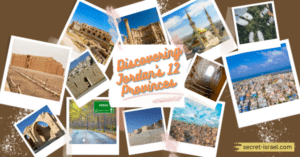
Explore Jordan’s 12 provinces, a fusion of history, culture, and beauty. From Amman’s historic citadel to Jerash’s Roman ruins

In this guide, we’ll take you through the top budget-friendly hostels to luxurious hotels in Zarqa, ensuring your stay
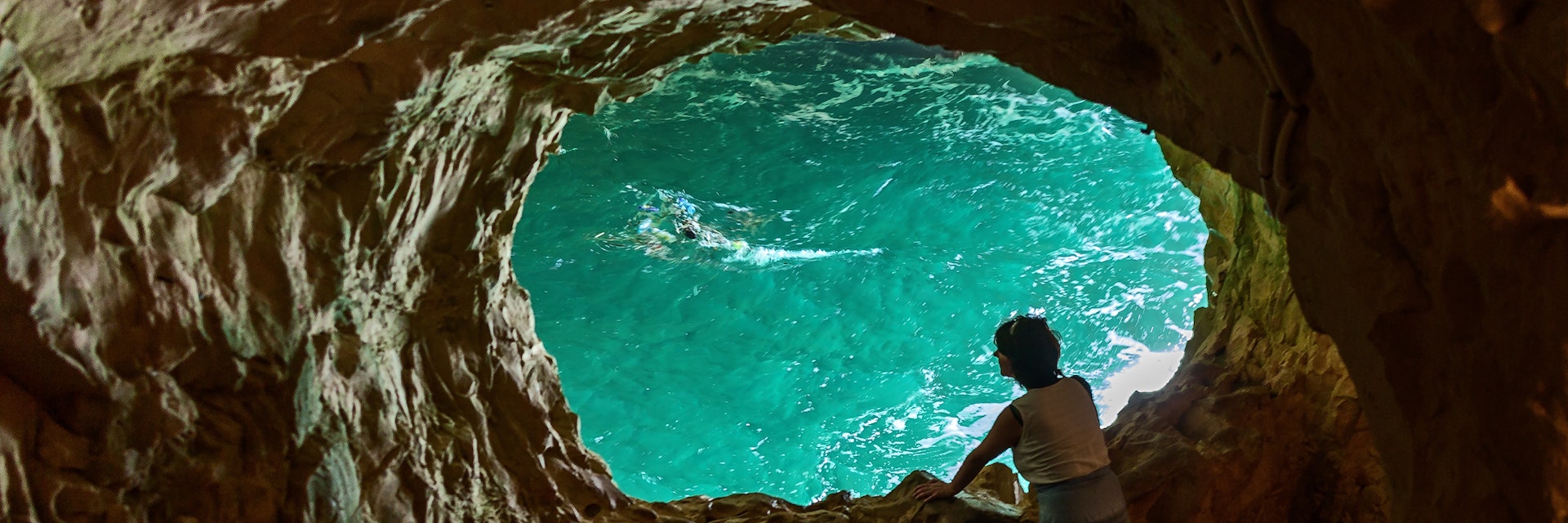
© Vadim Petrakov/Shutterstock
Rosh HaNikra Grottoes
Top choice in North Coast
Bone-white limestone cliffs seem to burst from the deep blue sea at this geological beauty spot straddling the Israel–Lebanon border. A cable car descends steeply to the bottom, a journey of barely a minute; from here visitors step into wave-sculpted cave mouths, listening to water mercilessly lashing the rock. If you listen very carefully you might hear fruit bats nesting in the rock folds.
The cable car is wheelchair accessible, but the caves are not. It's a good idea to wear shoes with grippy soles.
Behind the lower cable-car station, inside a naturally cool rail tunnel, you can watch a film on the area's geography and the history of the Haifa–Beirut railway, whose tunnels were excavated by British army engineering units from New Zealand and South Africa in 1941 and 1942. Unsurprisingly, the line has been out of commission since 1948.
At the ticket windows, it’s possible to hire a bike (72NIS including the grottoes) for the 5km round-trip ride to Betzet Beach .
Up top, you can peer through a camouflaged border gate on the Israel–Lebanon border and pose for a picture next to a sign pointing to Beirut. A few kilometres north is the Naqoura base of the 12,000-member United Nations Interim Force in Lebanon (Unifil), which has been patrolling the border since 1978.
If you're hungry, there's a snack bar down below and a cafeteria and restaurant next to the border gate.
Nateev Exprees bus 31 links Rosh HaNikra with Nahariya (7.40NIS, 17 minutes, every 1½ to two hours except Shabbat).
Rosh HaNikra
Get In Touch
073 271-0100
https://www.rosh-hanikra.com
Lonely Planet's must-see attractions
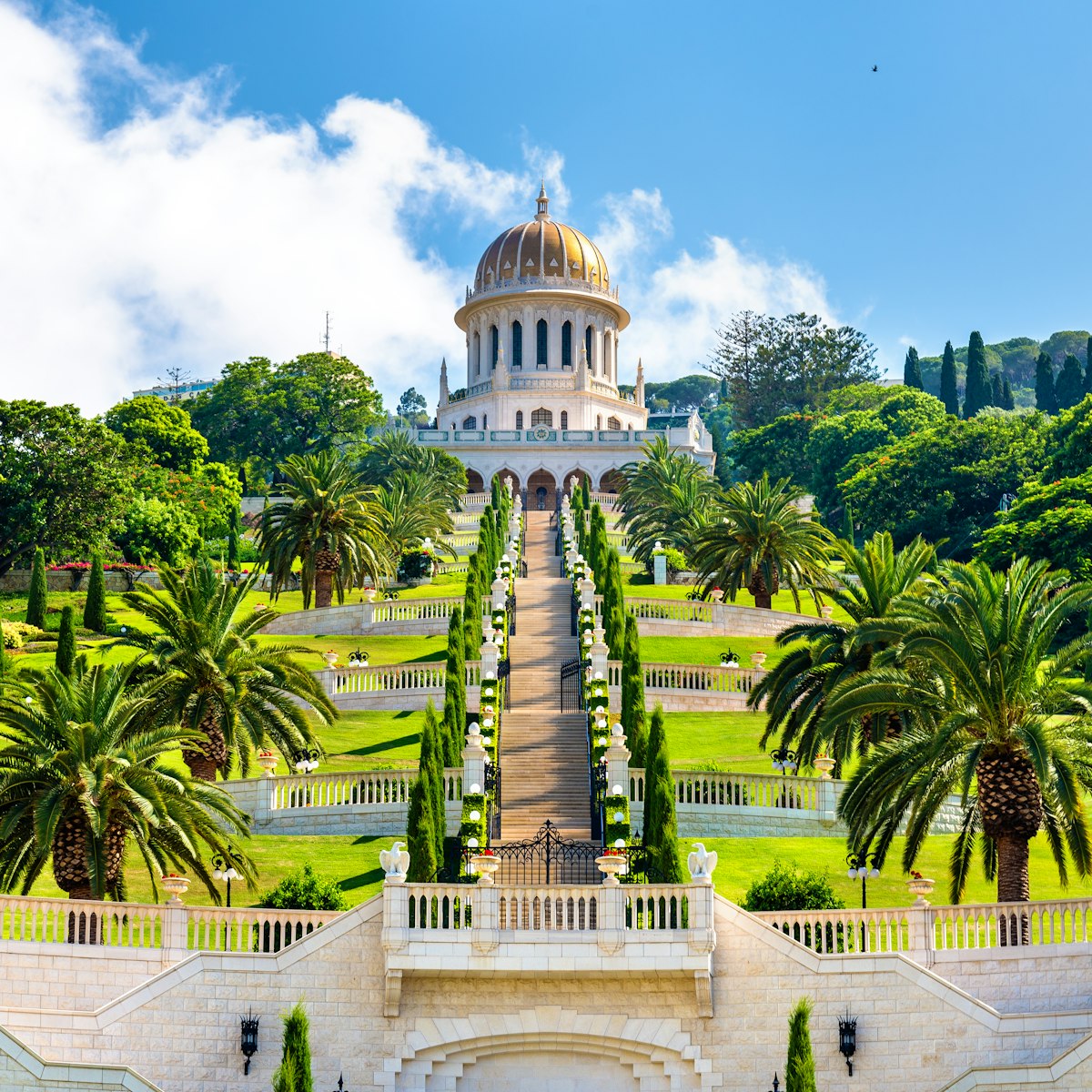
Baha’i Gardens
20.54 MILES
These formal gardens flowing down 19 steep terraces to a resplendent domed shrine – the final resting place of the prophet-herald of the Baha’i faith –…
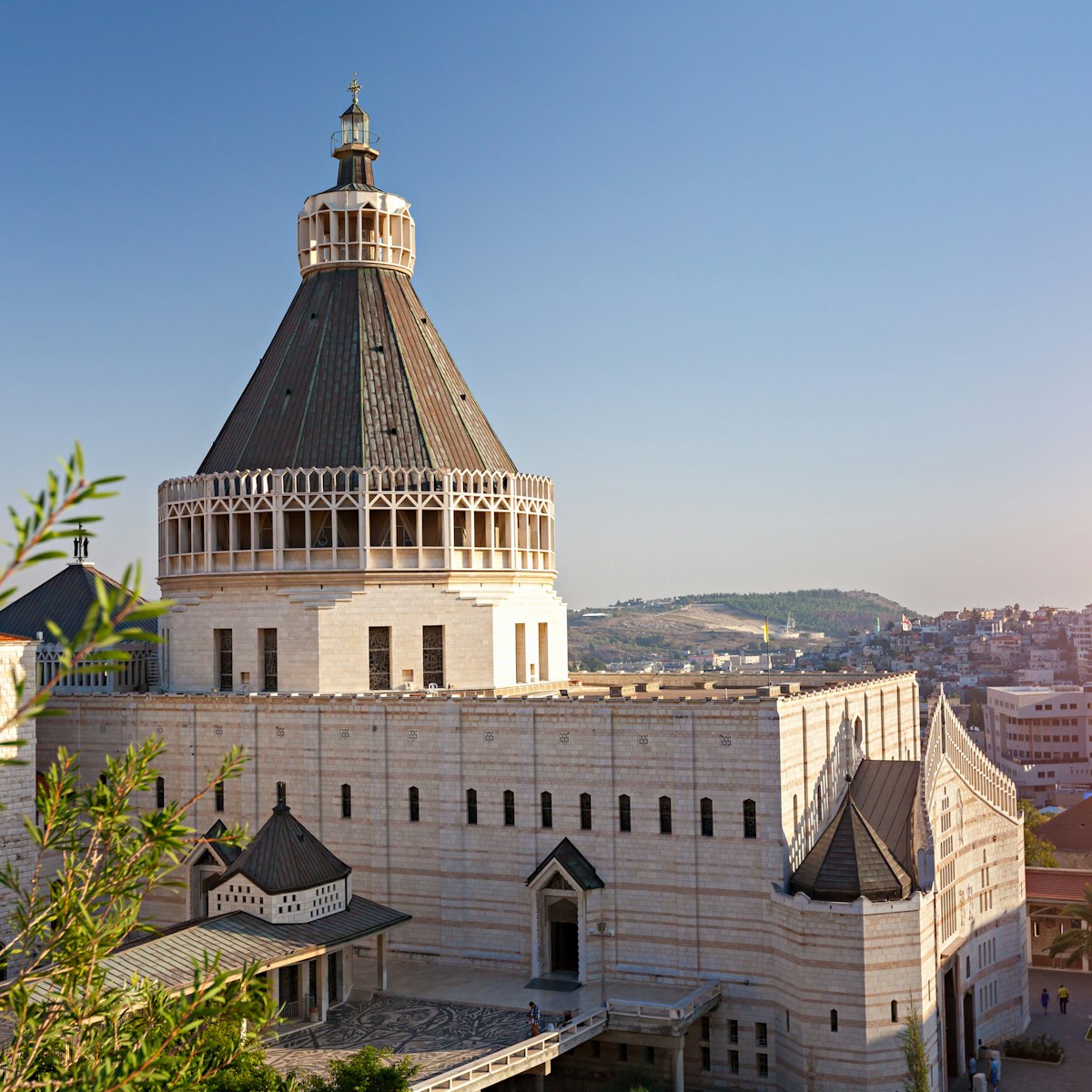
Basilica of the Annunciation
29.02 MILES
Dominating the Old City’s skyline is the lantern-topped cupola of this Franciscan-run Roman Catholic basilica, an audacious modernist structure that’s…
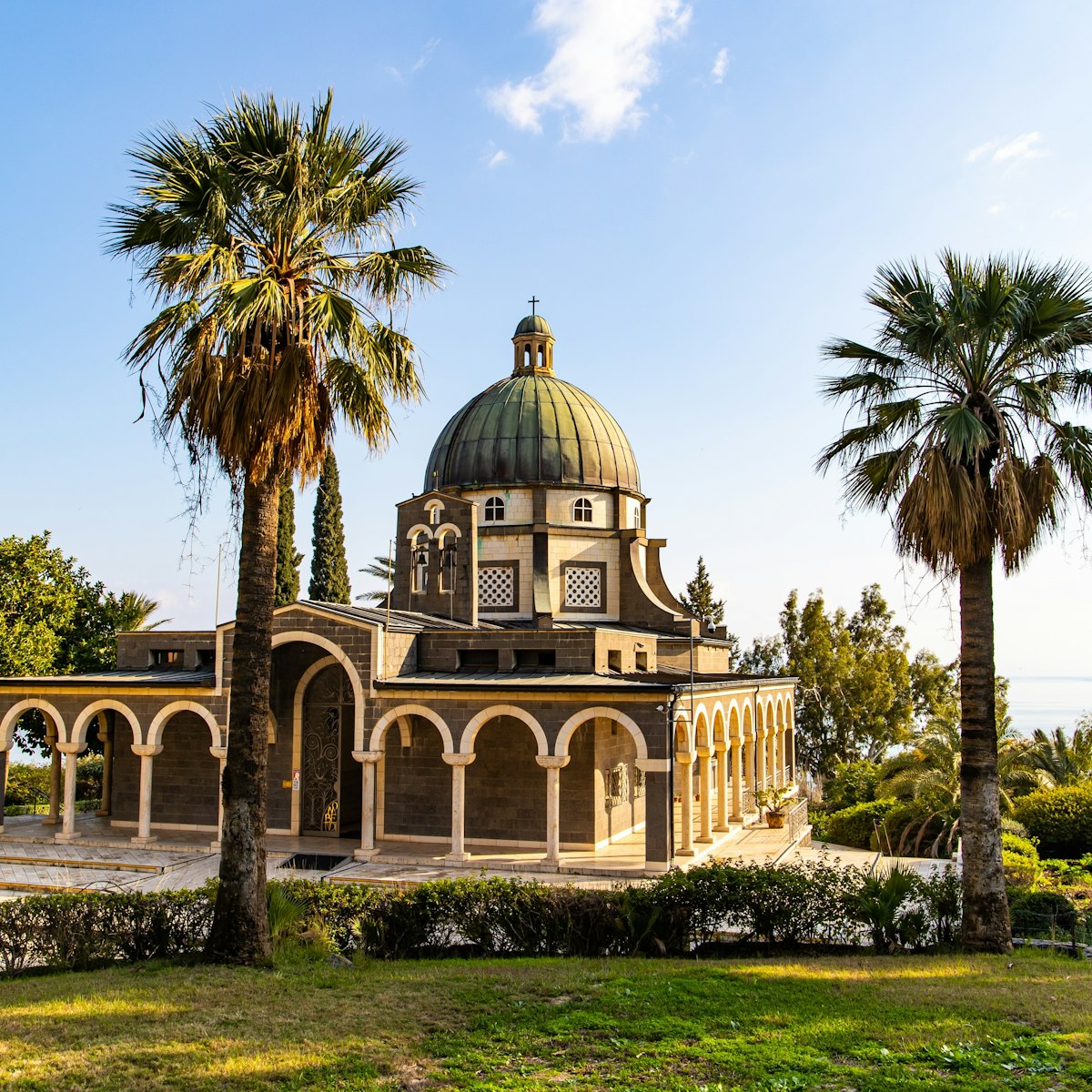
Mount of the Beatitudes
29.84 MILES
Since at least the 4th century, this landscaped hillside is believed to be where Jesus delivered his Sermon on the Mount (Matthew 5–7), whose opening…
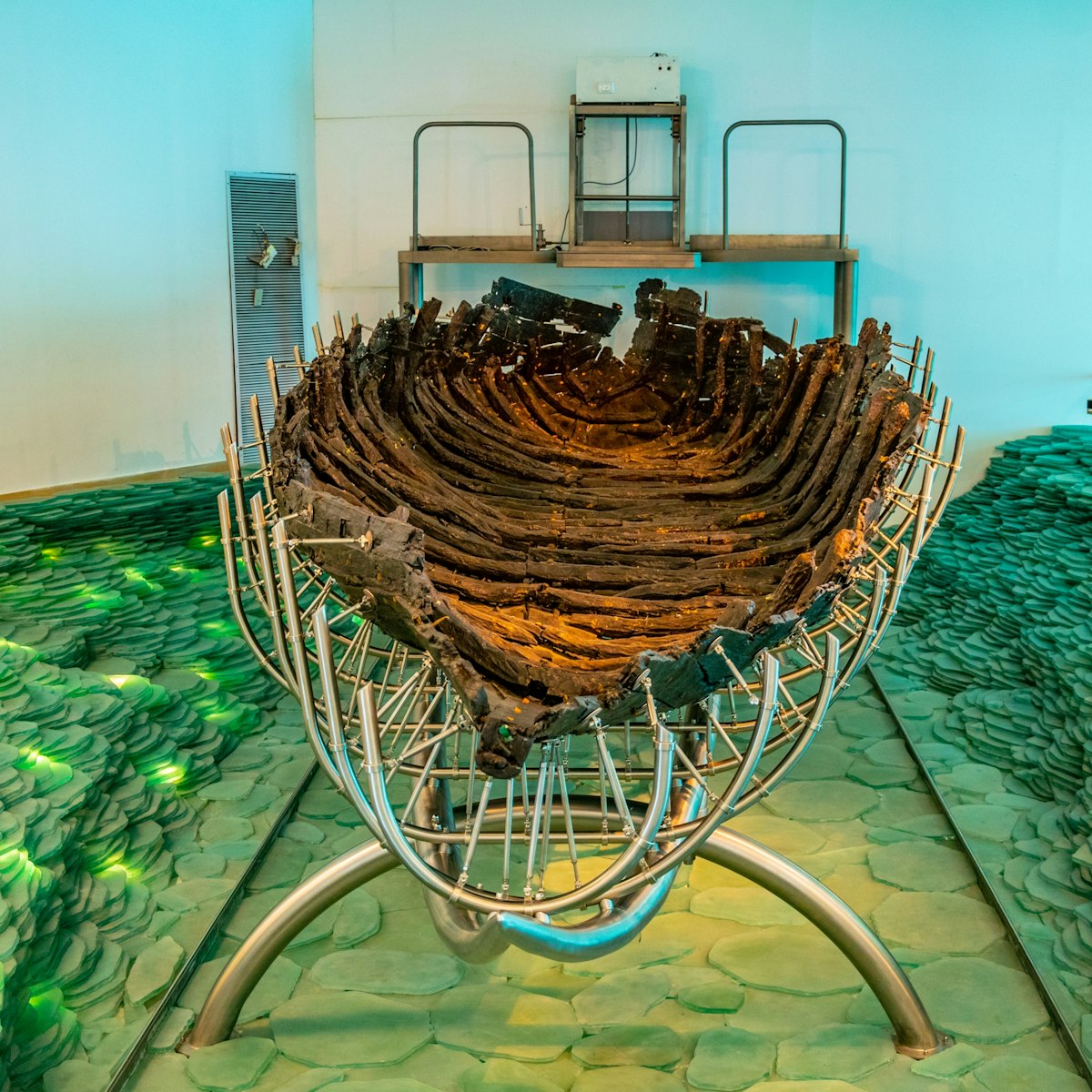
Ancient Galilee Boat
29.62 MILES
In 1986, when the level of the Sea of Galilee was particularly low, a local fisherman made an extraordinary discovery: the remains of a wooden boat later…
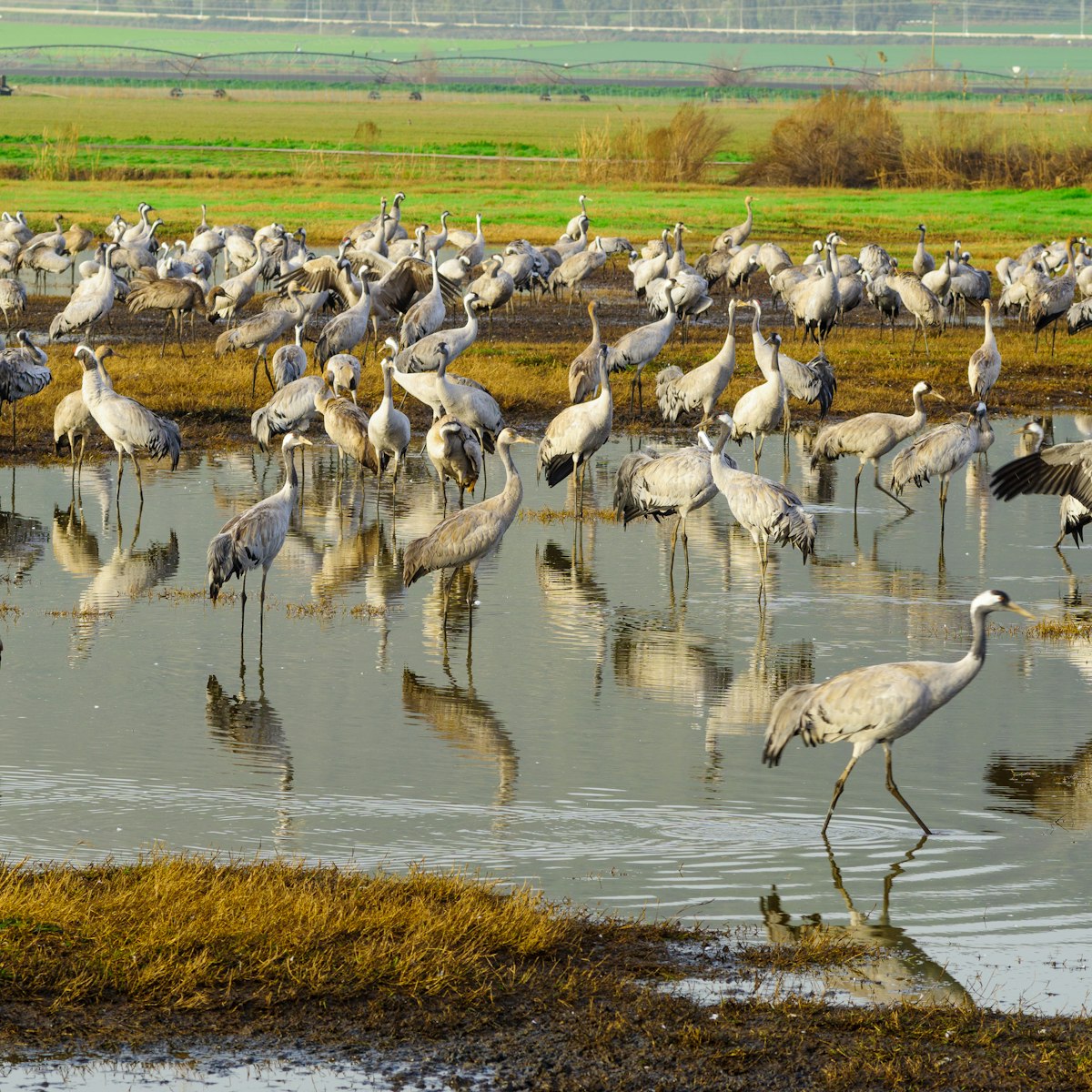
Agamon HaHula
28.89 MILES
These restored wetlands are one of the best places in Israel to see cranes, pelicans, storks and an incredible 400 other bird species. To cover the 8.5km…
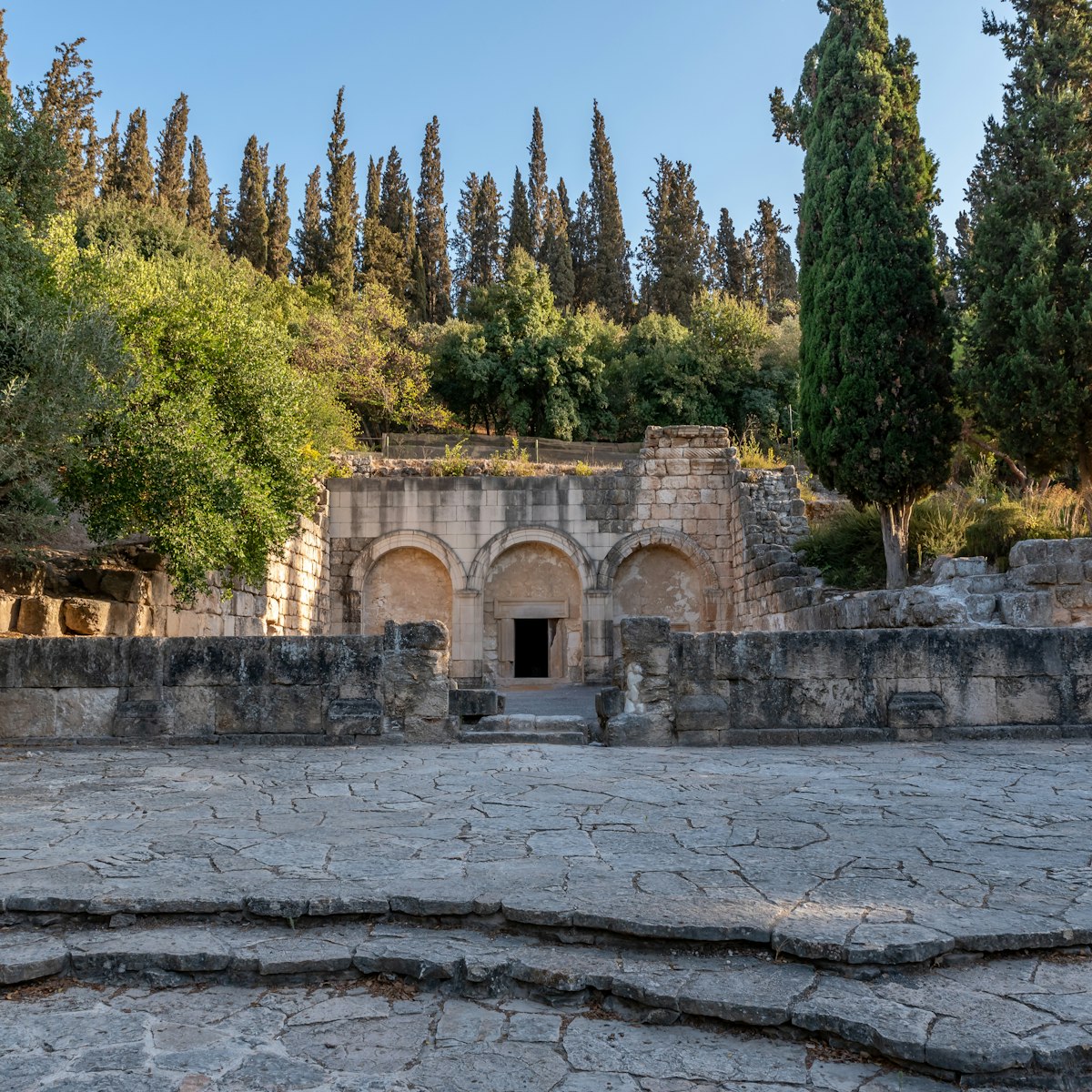
Beit She’arim National Park
26.69 MILES
Nestled between Mt Carmel and Lower Galilee, spellbinding Beit She’arim is pitted with ancient catacombs, many of which you can enter. In the 2nd century…
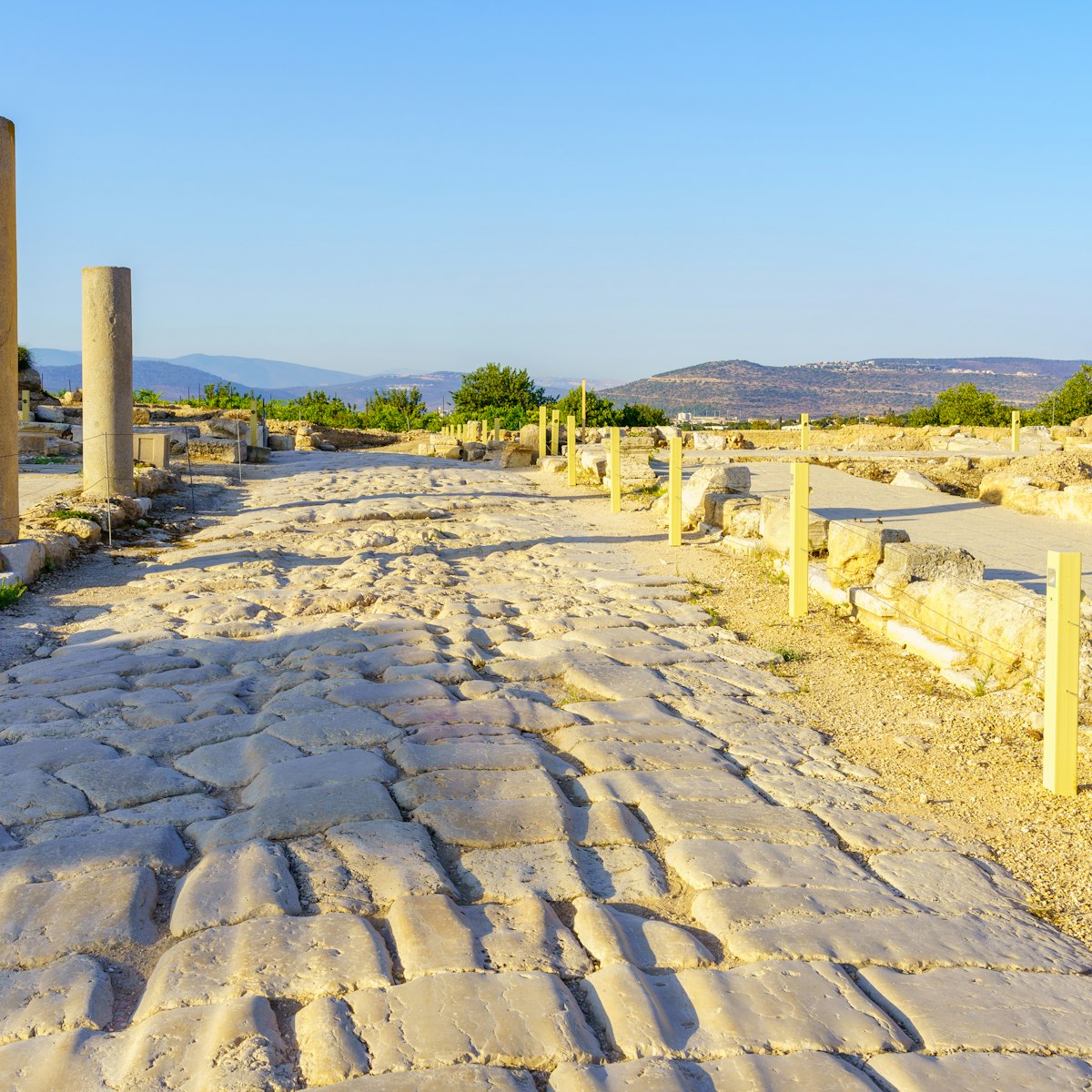
Tzipori National Park
25.64 MILES
In ancient times, Tzipori was a prosperous and well-endowed city with stone-paved roadways (you can still see the ruts left by Roman wagons), a…

Hula Nature Reserve
28.85 MILES
Migrating birds flock to the wetlands of Israel’s first nature reserve, founded in 1964. More than 200 species of waterfowl mingle happily with cormorants…
Nearby North Coast attractions
1 . Akhzivland
So irresistible is the pull of this sparkling stretch of coast that nonconformist activist Eli Avivi declared it an independent state in 1971, irritating…
2 . Akhziv National Park
About 5km north of Nahariya, Akhziv National Park has broad lawns, traces of a Phoenician port, and a small, shallow, family-friendly beach. Changing…
3 . Montfort Castle
Originally built by the noble De Milly family, what remains of Montfort Castle is a striking ruin, reached by a pleasant hike. The castle’s name was…
4 . Beit Lohamei HaGeta’ot
Founded in 1949, the same year as the kibbutz, the world's first Holocaust museum focuses on the Warsaw Ghetto Uprising. The kibbutz founders considered…
5 . Yad Layeled Children’s Memorial Museum
This powerful memorial to the 1.5 million Jewish children killed in the Holocaust is housed in a circular building, intended to symbolically unify their…
6 . Aqueduct
Built by Al Jazzar around 1780 and reconstructed in the early 19th century, this Ottoman aqueduct once supplied Akko with water from the Galilee uplands…
7 . Baha’i Gardens
10.13 MILES
While they don’t match the scale of Haifa's strikingly steep Baha’i Gardens, these formal gardens are utterly picturesque, with meticulously tended flower…
8 . Shrine of Baha’ullah
10.25 MILES
At the far end of the Baha’i Gardens is the Shrine of Baha’ullah, the simple and serene final resting place of the Baha’i faith’s founder. For both men…

Rosh HaNikra – Full Guide to Stunning Seaside Grottoes
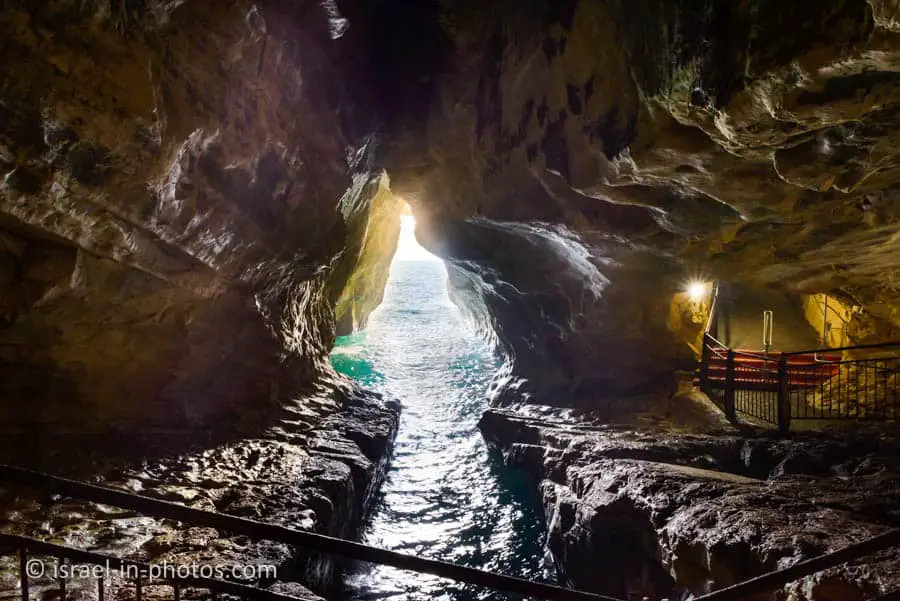
Rosh HaNikra is a geologic formation near the border with Lebanon. Sea activity on white chalk rock formed the grottoes.
Table of Contents
- 2 Directions
- 4 Opening Hours
- 5 Entrance Fee
- 8 What does Rosh HaNikra mean?
- 9 Entrances
- 10 Cable Car
- 11 Audiovisual Presentation at Rosh HaNikra Grottoes
- 12.1 Cairo-Istanbul Train
- 13.1 The Big Grotto
- 13.2 Pigeon Bridge – Lucky Bridge?
- 13.3 The Elephant’s Leg
- 14 Driving an Electric Golf Car at Rosh Hanikra Sea Reserve
- 15 Rock hyrax
- 16 Kayaking at Rosh HaNikra
- 17 Rosh HaNikra Islands
- 18.1 Achziv National Park
- 18.2 Photos of the Beach at Sunset
Rosh HaNikra is located north of Nahariya, north of Achziv National Park , and next to Lebanon’s border. Rosh HaNikra Grottoes is a white chalk cliff face that opens into spectacular grottoes. The nearby Achziv National Park has one of the most beautiful beaches in Israel. And I am mentioning both nearby attractions since you can combine them into a half-day visit. Also, the Rosh HaNikra village is nearby.
Directions for drivers: Link to Waze and Link to Google Maps Directions for public transport: Link to Moovit
Interactive map of the area:
- Hotels, hostels, and apartments in this area:
- Buy photos of Israel and support this blog.
- Get 10% off for your next tour at Bein Harim with coupon code LEV10#12306.
If you are reaching by car, drive along road #4 to the north. You will drive along the sea till you get to the end. You should see signs directing you to the grottoes as you approach closer.
Reaching by public transport is less convenient but also doable. First, you need to get to Nahariya. You can do this using buses or trains, depending on your location. Then, from Nahariya, you can take a taxi or bus #31. Here are the directions from Tel Aviv to Rosh HaNikra Grottoes using Moovit . You can also update Moovit with your starting point and get the revised instructions.
There are free parking spaces next to Rosh HaNikra Grottoes. But if you arrive later in the day (for example, after 11 am on a Saturday), there might be no free spaces at the parking lot. You can still park along the leading road, which will add to extra walking.

Note: As seen in the photo above, restrooms are in the far left corner of the parking lot.
Opening Hours
Sunday – Thursday: 09:00-18:00 (till 16:00 in the winter) Friday: 09:00-16:00 Saturday: 09:00-17:00
Entrance Fee
Adult (18+) – 49 NIS. Child (3 – 18) and pensioner – 39 NIS. Babies and toddlers (0 – 3) – free. Audio guide rental – 14 NIS.
There are several types of combined tickets. The first type offers a visit to Rosh HaNikra Grottoes and a bicycle or a golf car drive along the beach. It costs 77 NIS per adult and 69 NIS per child. The second combo ticket offers a combined ticket to Rosh HaNikra Grottoes and various attractions in Old Acre . If you want to visit the Templars Tunnel , Hospitaller Fortress (Knights Halls) , Hamam al-Basha, and Treasures In The Walls Museum , it will cost 80 NIS per person.
Note: the combo tickets and the prices change from time to time. Thus, check the official site before visiting.
If you purchase tickets at the official site , there will be a small discount (43 NIS per adult and 35 NIS per child). Here are additional coupons I found online:
- 1+1 at MAX (in exchange for a treat)
- cpnclub.co.il – 44 NIS per adult and 36 NIS per child. It is higher than the prices on the official site.
- Members of teachers association – 30 NIS per adult and 33 NIS per child.
- Rosh HaNikra is not part of the Israeli National Parks Authority. Thus, a Matmon card will not provide any discounts.
- Opening hours and ticket prices were updated in July 2022. In any case, recheck the official site before visiting.
I just wanted to mention that Rosh HaNikra is a popular tourist site, and many firms offer tours. Usually, these tours include several nearby attractions, and this site is one of them. For example, Old Acre and Rosh HaNikra. If you are short on time or love traveling with tours, consider joining.
What does Rosh HaNikra mean?
In Hebrew, Rosh HaNikra means “the head of the grottoes,” in other words, the best Grottoes.
The site has two entrances – the main, the upper, and the lower, next to the beach.
We came to the upper entrance. At the top entry, you can find a large parking lot. But since Rosh HaNikra Grottoes is a popular site, the parking may be full if you come later in the day.
Here is the view to the south of the beach, Nehariya, and Haifa:
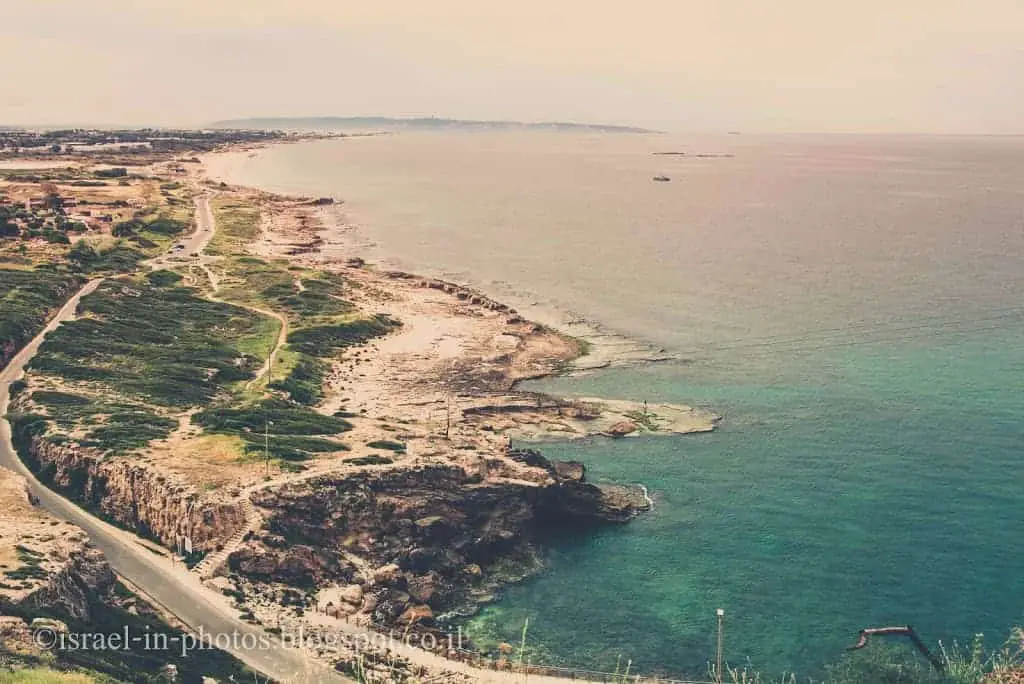
People usually associate crystal clear water with Greece, but some beaches in Israel look very similar to Greece. Achziv Beach and nearby ones are among Israel’s favorite and highest-ranking beaches.
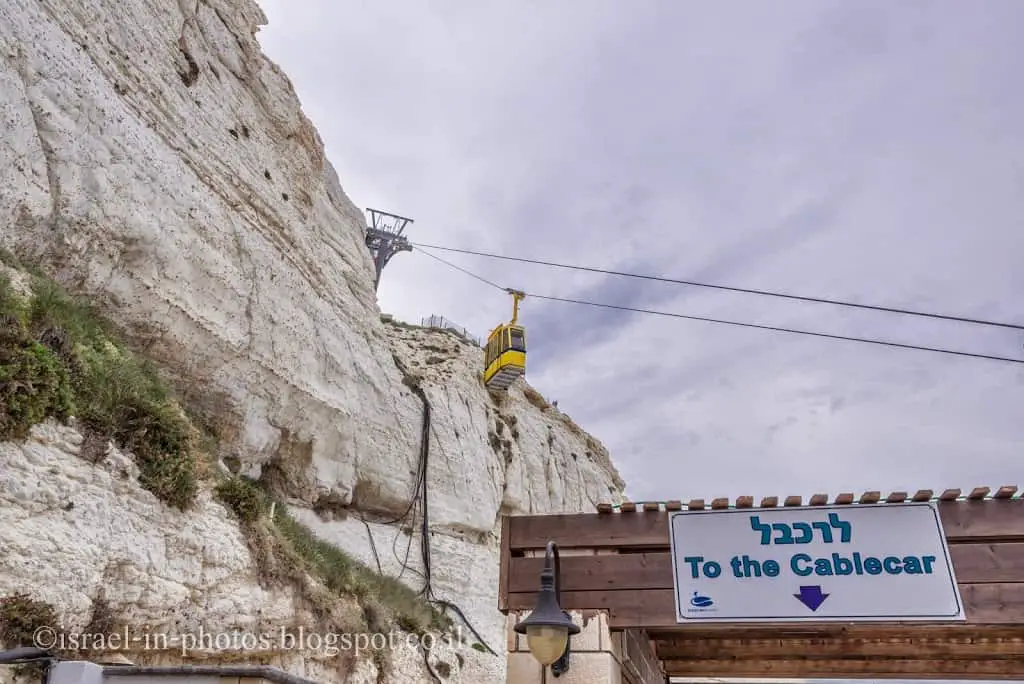
Reaching the caves from the top entry is done by cable car. They say it is the steepest cable car in the world (gradient of 60 degrees). But it is probably also one of the shortest ones. The ride takes about two minutes.
Also, since it is tiny (as far as I remember, the maximum capacity is eight people), I recommend getting to Rosh HaNikrah either early or late. Otherwise, you may get stuck in the queue for the cable car.
As you get off the cable car, you will see the following sign:

I suggest starting with the audiovisual presentation. To reach it, you turn left and go till the end.
Audiovisual Presentation at Rosh HaNikra Grottoes
After getting off the cable car, I recommend starting with the movie about this place. There is a screening every 15 minutes. And there are displays in different languages.
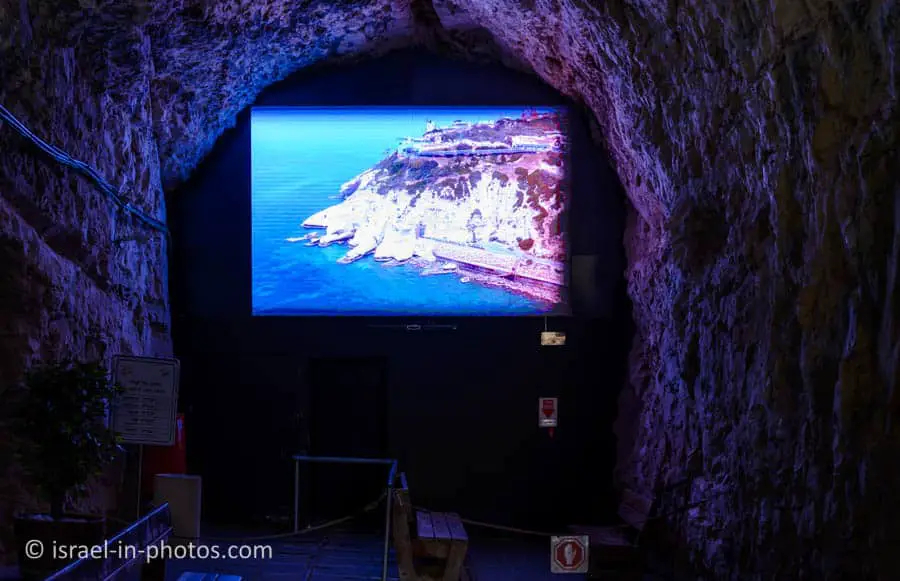
The film tells the history of this place and the geological history of the Grottoes. Plus, the story of the British Cairo – Istanbul railway.
The Book of Joshua mentions “Misraphot Mayim” as a place south of Rosh HaNikra that was the border of the Israelite tribes of the time. In the First Book of the Maccabees, it is referred to as the place that Shimon HaHashmonai was responsible for in 144BCE (1 Maccabees 11:59). Josephus Flavius also describes Rosh Hanikra as the northern border of the city of Acre, Israel. (The Jewish War 2, 10, 2). The archaeological tell is today situated within the kibbutz. In the Jewish apocryphal First Book of Maccabees (1 Macc 11:59), a cape in this region is referred to as “The Ladder of Tyre.” The author could have meant either the cliffs at Rosh HaNikra or one of two other capes jutting out into the sea slightly north or south of them. The site was later named an-Nawakir (“The Grottoes”) by the Arabs.
Cairo-Istanbul Train

Rosh HaNikra has served as a passage point for trade caravans and armies between Lebanon, Syria, Israel, Egypt, and Africa. During the Second World War, South African forces blasted railway tunnels through the nearby rocks for trains running along the Cairo-Istanbul line. The Haganah spared the railway bridge at Rosh HaNikra during the 1946 Night of the Bridges operation. But following a late-1947 British announcement that it would withdraw from Palestine months ahead of schedule, the bridge was destroyed by the 21st Battalion under the Palmach in late February 1948 to hinder Lebanese arms shipments to Arab forces opposing the UN Partition Plan. As repairs were prohibitively expensive, the tunnels were later wholly sealed. The Lebanese railways have been dismantled mainly while the Coastal Railway in Israel currently ends near Nahariya, several kilometers to the south. Rosh Hanikra was the location where Israeli and Lebanese officials negotiated and concluded an armistice agreement in 1949, which ended the Lebanese-Israeli component of the 1948 War of Israeli Independence. A border passage across the Blue Line into Lebanon at the site is sometimes used by UNIFIL personnel.
Source: Wikipedia
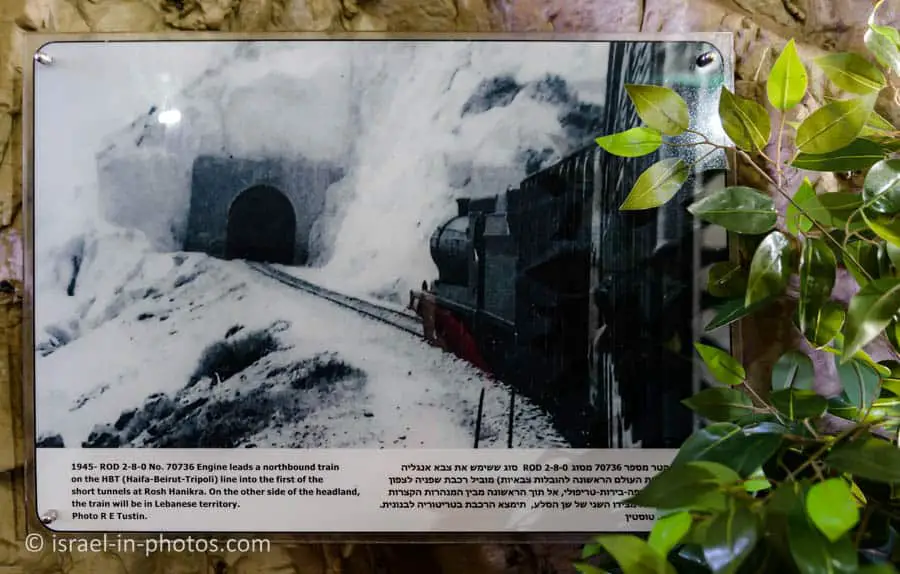
The Grottoes
Our next stop will be the grottoes.
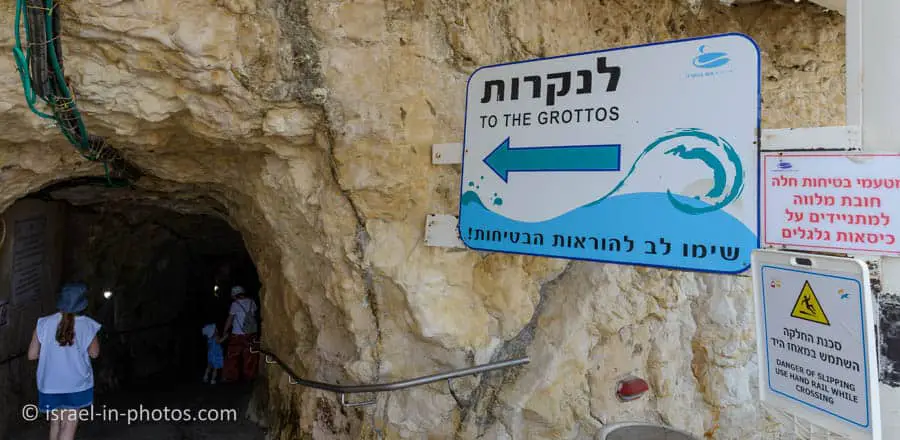
Keep in mind that the stones might be wet and slippery. Thus, walk cautiously and use rails when needed.
The Big Grotto
When stormy, huge waves enter the grotto, pounding and powerful. They close off the opening, compressing the air within and causing momentary darkness… until the powerful breaking wave rocks the cliff foundation and partly floods the path before you. Grotto height – 16 meters. At its top live fruit bats, feeding off fragrant ripe fruit growing here. The bats live in colonies, enjoying a life expectancy of about twenty years. The fruit bat has good intact vision, and unlike widely believed, it doesn’t become entangled in people’s hair. On quiet days you can hear the bats screaming and chirping.
Source: sign

The path in the caves is not very long. It took us about fifteen minutes (including taking photos) to reach the pigeon bridge (the end of the underground route).
Pigeon Bridge – Lucky Bridge?
In the giant rock cleft above us, the rock pigeon makes its nest. The place provides a refuge from the weather, allowing it to nest in peace. Watch out for the pigeon’s droppings, but know this… It brings good luck!! From the observatory overlooking the sea, you can see the flat coarse sand rocks – the work of the sea waves and winds constantly polishing the rock surface smooth.
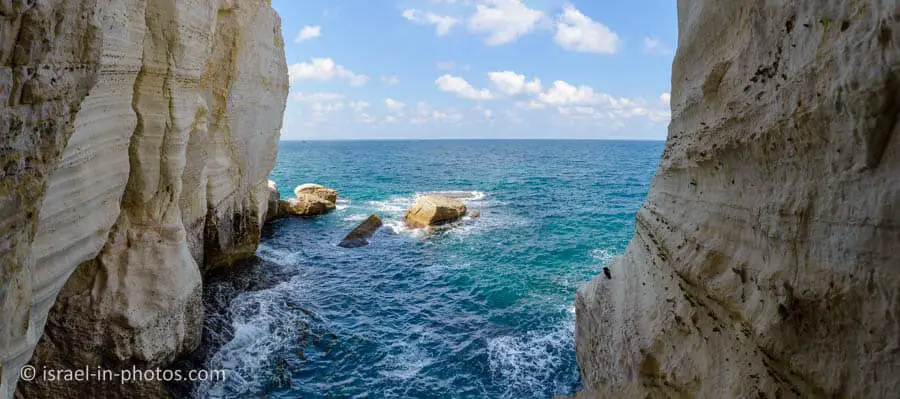
The Elephant’s Leg
Here is another scene of the white cliffs and the beach. If you look closer at the other ridge, you might think it resembles an elephant because the right part resembles a trunk or a leg. Thus, some people refer to this stone under the name elephant’s leg.

The never-ending encounter of sea and mountain created a natural stone sculpture shaped like an elephant leg. This is the edge of the cliff at the only point in Israel where the mountain descends into the sea without a sandy seashore. Glancing south, you can see the three islands. “Pale Blue” – mostly covered by water, “Seagull,” and “Wagtail.” The islands have been declared a nature reserve, as birds nest there. Silver seagulls, sea terns, white wagtails. The islands are the peaks of the western coarse sand ridge of Galilee’s coastal plain. When visibility is good, you can even see Haifa and the Carmel. Looking north, you can see the border buoys marking the Israel-Lebanon border and the Israeli Navy vessels, permanently moored here and protecting the northern coastline.
The caves are beautiful, but the trail is not that long. The Grottoes loop path takes around half an hour at a slow pace.
Driving an Electric Golf Car at Rosh Hanikra Sea Reserve
You can use the lower entry/exit (reached through the former railway tunnel) to explore the Rosh Hanikra Sea Reserve.

On one of our visits, we purchased a combined ticket. The ticket included an entrance to Rosh HaNikra and an electric car ride along the Rosh Hanikra Sea Reserve beach.
The ride in the electric car was limited by time. We got the car for a half-hour. The beach is not that long, and I think the part closer to Rosh HaNikra is the lovelier one. Thus, due to the short time and no real reason to go further away, I recommend not purchasing the combined tickets, including the electric car or bicycle rental. We enjoyed the walk along the beach (after returning the electric car) more than the ride in the car.
Another pleasant surprise at Rosh Hanikra Sea Reserve was hyraxes .
Since we saw food remains on the rocks, we guessed somebody was feeding them. And there were dozens of rock hyraxes close to the lower entrance.
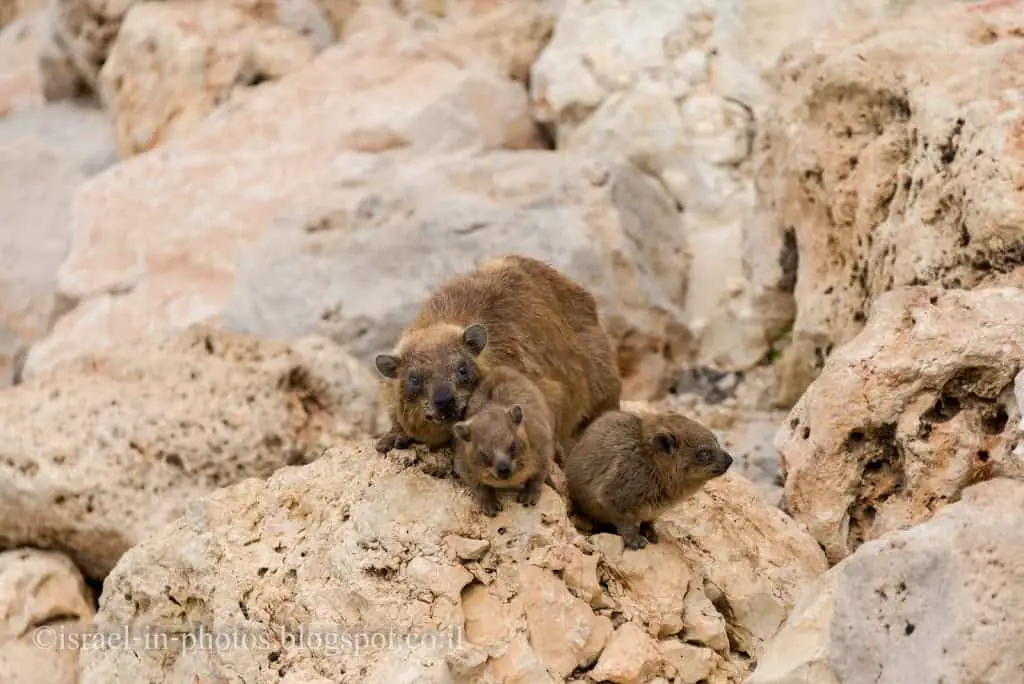
The water is crystal clear, and the rock formations are outstanding:

We ended our beach stroll, headed through the lower entrance, and back to the cable car. Also, when exiting Rosh HaNikra to the beach, ensure a staff member is putting a stamp on your hand. This way, you could reenter the site.

Kayaking at Rosh HaNikra
Different private firms offer Rosh HaNikra kayaking and sailing. Due to the closeness to the Lebanon border, such sails must be coordinated with the Israeli Navy. Thus, you can not kayak there by yourself.
I have not attended this activity yet, so I can not share my experience. However, if you are interested, here are several links to kayaking firms:
- kayaksailinisrael.com
- israel-extreme.com
- kayaktours.co.il
Rosh HaNikra Islands
Rosh HaNikra Islands are a group of four small islands in Achziv Nature Reserve. Due to their rich ecosystem, they cannot be visited.
The Rosh Hanikra Islands are part of an ancient coastline submerged by the sea. Only their peaks, a series of wind-blasted, perforated rocks – the largest of which is not much larger than the size of two tennis courts – are currently above sea level. Nonetheless, they are home to a surprisingly rich eco-system, and as such are protected by the authorities.
Source: jpost.com
The Rosh HaNikra Islands are a group of three Israeli islands in the Mediterranean Sea, named Shahaf, Nahalieli, and T’chelet. The islands are located approximately 800 meters offshore, near Rosh HaNikra. These islands are a single geological unit with the Achziv Islands that are further south. The depth of the seawater around them is approximately between 7 and 9 meters. The Rosh HaNikra Islands are characterized by many natural pools that provide a natural habitat for various life forms. The Rosh HaNikra Islands are a part of a natural reserve, and boarding these islands is prohibited. These islands are the only place in Israel where certain rare birds nest: the White wagtail, The European herring gull, and the Common tern. The waters surrounding these islands contain a wide variety of marine life. In ancient days, these islands had a certain economic and commercial significance as they were a natural habitat for the sea snail from which Tyrian purple dye was produced.
And now, let’s revisit the beach during the golden hour.
Rosh Hanikra Sea Reserve
In this section, I will show several photos from my visit to the beach for a sunset shoot. The rock formations and the crystal blue water were the main reasons for returning.
Rosh Hanikra Sea Reserve has an open beach (the one near the lower entrance), and you can enter at any hour. But, since I mentioned it, here is some basic info:
Achziv National Park
Akhziv Beach National Park, located about five kilometers north of Nahariya, features a rocky shoreline, inlets, and lagoons, and a natural and an artificial sea-water pool–a deep one as well as a shallow one suitable for children. There are also broad lawns and antiquities. In short, everything you need to enjoy hours of Israeli sunshine. Akhziv is unique for the sea anemones, sea urchins, and small octopi that can often be seen hiding among the rocks. And in July and August, the sea turtles that lay eggs on the beach. Small islands, where seagulls nest in summer, are nature reserves in their own right, remnants of once-landlocked calcareous limestone (kurkar) ridges. Remains can also be seen of the ancient settlement of Akhziv, mentioned in the Bible as a city of the tribe of Asher, and an essential Jewish town in Talmudic times. A mainstay of Akhziv’s ancient economy was the production of purple dye from particular snails collected on the beach. In Crusader times Akhziv was called Castel Humbert, ruins of which can still be seen. In 1271 it was conquered by the Mamluk Sultan Baibars. Most of the remains you see today are from the abandoned Arab village of Az-Ziv.
Source: Israel Nature and Parks Authority
I have a dedicated post for this national park. And you can find additional information at Achziv National Park .
Photos of the Beach at Sunset
Last Friday, I was there during the golden hour, and today, I will show you several of my photos.
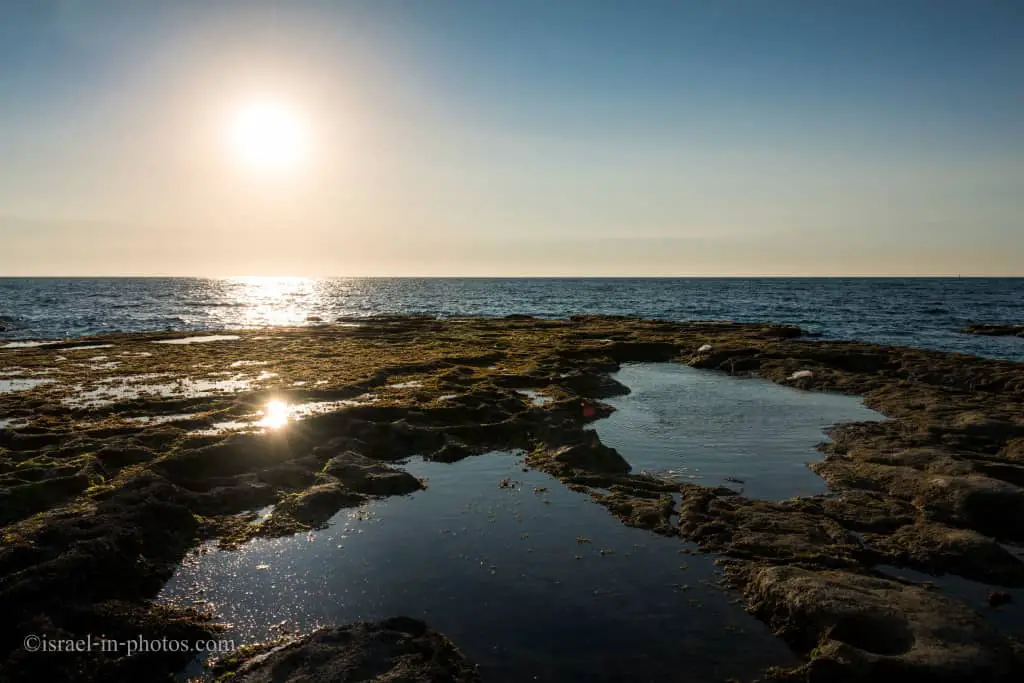
You can see military ships patrolling. That is because it is very close to the Lebanon border.

These small ponds or lagoons are gorgeous. And since they are directly connected to the sea, you can see small fish and lobsters if you stand there for a while. At least, that is what I saw.
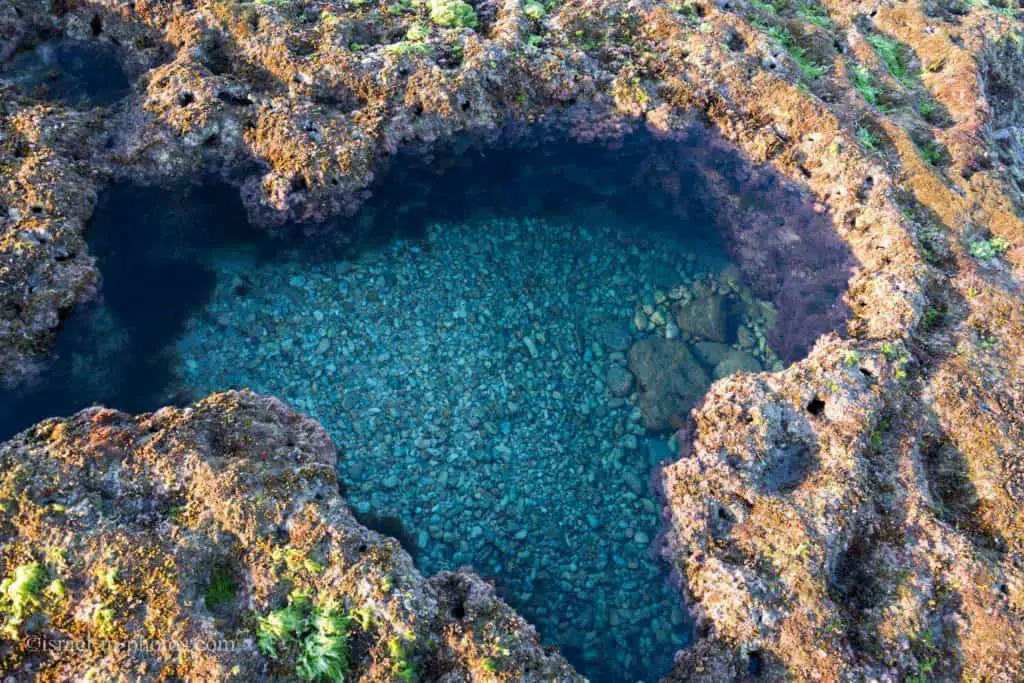
There were several anglers on the beach. The one close to me had two fishing rods. When I took this photo, the fisherman was at the other fishing rod:

Some rocks are covered with greenery, and they are very slippery.

Just after the sun sets is my favorite shooting time. The skies become more vibrant and exciting, and I get longer exposures, which means smoother water.

The fisherman decided to pose for me a little 🙂

To portray the feeling, the photo above is a 15-second exposure, and during those 15 seconds, the fisherman barely moved. So, I guess he also thought that it was a beautiful sunset.
Though the photos look pretty bright (due to the long exposures), it was already very dark, and I could not move without a flashlight.
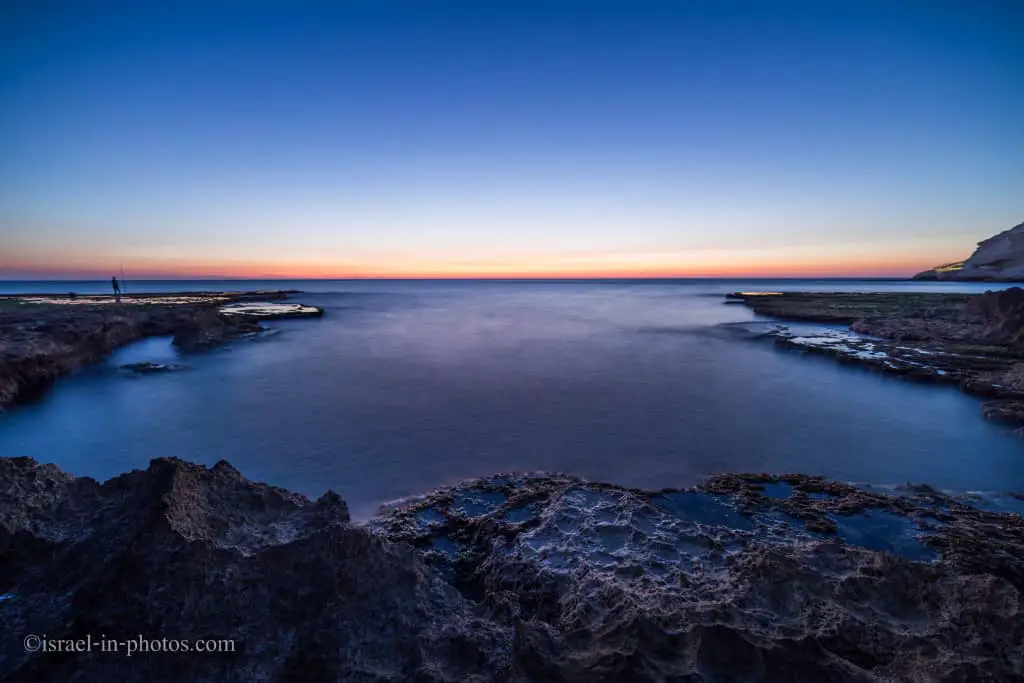
Rosh Hanikra Sea Reserve is quite far away from the big cities, and there is not a lot of light pollution (besides Haifa on the far left). Thus, you can see many stars:

This is a combo of two photos. One just as the sun reached the horizon and another well after the sunset (you can even notice some stars). It is my latest addition to the Day To Night .
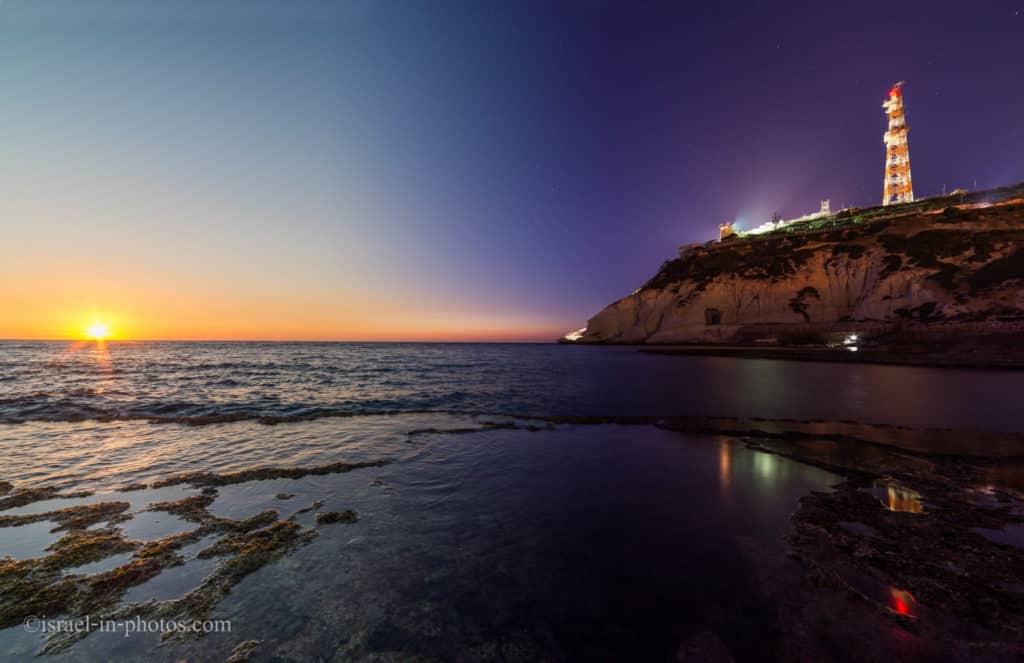
Rosh HaNikra is gorgeous, and we have enjoyed all our visits. The site is not vast, and two hours will probably be enough to explore the grottoes and the lookout.
Because there are no limitations to the number of people that can visit this site at any point, during rush hours, you will spend a lot of time waiting (for the cable car, presentation, parking, and so on). Thus, I would advise coming early. The second best option is to visit later in the afternoon. And skip the golf cart and bicycles.
Since it is a relatively short attraction, you can combine it with other places in this area – for example, the beautiful nearby Achziv National Park or Keshet Cave . You can use the interactive map at the top of this post to find nearby attractions.
Have you ever visited Rosh HaNikra Grottoes? How was your experience? Tell us in the comments below.
That’s all for today, and I will see you in future travels!
Stay Tuned!
Additional Resources
- Israel Trip Planner is the page that will help you to create your perfect travel route.
- National Parks And Nature Reserves page lists and put all national parks on the map. There is also a top list, information about ticket types and campsites.
- If you are looking for things to do, here are the pages for Jerusalem , Tel Aviv , Haifa , Sea Of Galilee , and Makhtesh Ramon .
- Wondering what events are there in Israel? Here is the Events And Festivals By Season guide.
Lev Tsimbler
Lev from israel-in-photos.com. You can contact me at [email protected]
Leave a Reply Cancel reply
Your email address will not be published. Required fields are marked *
Save my name and email in this browser for the next time I comment.
Recent Posts
Gibton Springs Nature Reserve - Visitors Guide
Gibton Springs Nature Reserve near Mazkeret Batya offers an easy hike through water sources, a eucalyptus grove, and Tel Malut. Map Gibton Springs Nature Reserve near Mazkeret Batya (behind...
Rehovot Citrus Park - Visitors Guide
Rehovot Citrus Park has an ecological pond, playgrounds for children, picnic tables, and more. It is a good place for family time. Map Rehovot Citrus Park is behind Rehovot Cemetery - Yehuda...

A combined ticket for a visit to Rosh Hanikra + a visit to Old Akko.
The combined ticket allows you to enjoy a visit to the Rosh Hanikra tourist site, including going down and up in the cable car, an independent tour of the grottoes and watching a video, and then continue independently to Old Acre and visit the Knights’ Halls, the Templars’ Tunnel, the Okashi Museum, the Museum of Treasures in the Wall and the Turkish bath-house, all for a discounted price. The combined card is valid for an adult/child/senior citizen or a soldier. For more details about the visit to Akko, you can call 04-9956706.
**By purchasing here on the site you will enjoy discounted prices
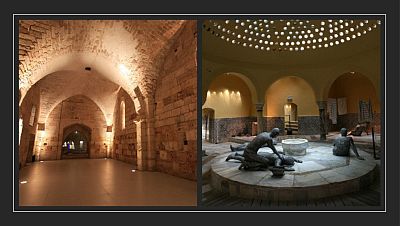
אולי יעניין אותך גם..

combined ticket for an adult: a visit to Rosh Hanikra + a visit to Jump Island, Lake Monfort, Maalot

An attraction for children in the north – combined ticket for a child, a visit to Rosh Hankara + a visit to Island Jump, Lake Monfort Ma’alot
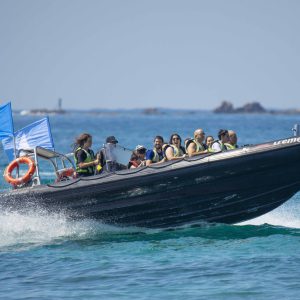
A combined adult ticket: a visit to Rosh Hanikra + Tornado boat ride
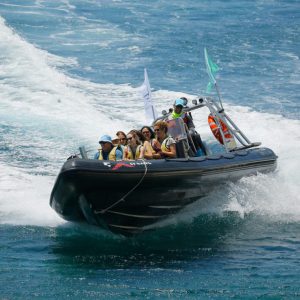
An attraction for children in the north – a combined child ticket: a visit to Rosh Hanikra + Tornado boat ride
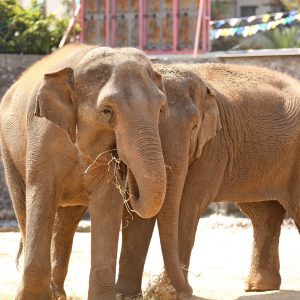
Combined Cable car + Chai Park, Kiryat Motzkin ticket (adult/child)
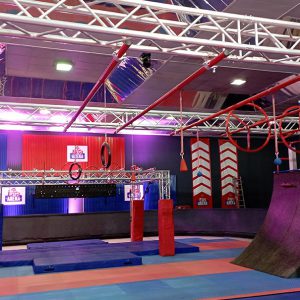
A cable car + Ninja combined child ticket at Lake Montfort, Maalot
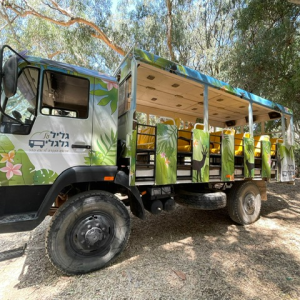

Off road truck ride + site visit – child ticket
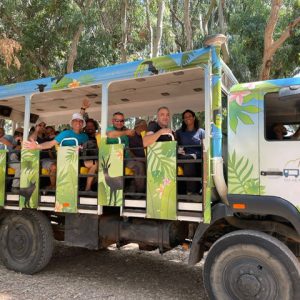
Off road truck ride + site visit – adult ticket
- עברית ( Hebrew )
- العربية ( Arabic )
שלחו לנו הודעה
- Daily Tours Jerusalem Day Tours Tel Aviv Tours Dead Sea Day Tours Galilee & Golan Day Tours Bethlehem & Jericho Christian Day Tours Tours from Tel Aviv Tours from Jerusalem
- Tour Packages Mini Packages, 2-3 Days Classical Tour Package Christian Tour Package Jewish Tour Package Galilee & Golan Package Israel and Jordan
- Private Tours Jerusalem Private Tours Dead Sea Private Tours Galilee Private Tours Israel Shore Excursions Airport Transfers
- Destination Jerusalem Tours Dead Sea Tours Masada Tours Nazareth Tours Galilee & Golan Tours Tel Aviv Tours Caesarea Tours Bethlehem Tours Jericho Tours Petra & Jordan Tours
- Petra Tours Petra from Jerusalem Petra from Tel Aviv Petra from Eilat Petra 1-Day Tours Petra 2-Day Tours Jordan Tours from Israel Israel and Jordan
- Shore Excursions Haifa Shore Excursions Ashdod Shore Excursions
- Blog Activities in Israel Israel Culture Practical Travel Info Jordan Travel Guide

- Bein Harim Israel Tours
Rosh Hanikra Grottoes

- Description
- Show On Map

About this place
The Rosh Hanikra cliffs stand majestically on the most northerly point of Israel’s Mediterranean coast just meters before the Israel-Lebanese border. The bright blue sea crashes against the white cliffs. Light reflects off of the white cliffs onto the seawater creating a beautiful turquoise color. The Rosh Hanikra cliffs are riddled with natural grottos that are now accessible to tourists. The Rosh Hanikra caves were probably formed when an earthquake caused fissures and crevices in the limestone rock through which rain could slowly penetrate. Over thousands of years, the rain trickled in through the cracks and waves bombarding the cliffs eroding the chalk and limestone. Today there are 200 meters of cavities, tunnels, and chambers that create a labyrinth of caves in the cliffs of Rosh Hanikra.
A Brief History of Rosh Hanikra
Rosh Hanikra’s strategic position on the route from Europe, Turkey, Syria, and Lebanon down into the Holy Land and on to Egypt, Africa, and the Arabian Peninsula meant that over the years many armies, pilgrims, and trade caravans passed this way. Among the ancient armies that would have taken the coastal road past Rosh Hanikra, there were Assyrians, Persians, Romans, Greek, Ottomans, and Crusaders. During World War I the British took Palestine from the Ottomans and their allies the Germans while the French took Lebanon and Syria. In order to facilitate the movement of troops and a connection to their French allies the British paved a road along the coastline through Rosh Hanikra. In doing so any evidence of ancient routes was destroyed. In World War II the British planned a rail line between Istanbul and Cairo. South African troops were employed to blast three railway tunnels through the rock of the Rosh Hanikra cliffs. The British and their allies also built a suspended bridge at Rosh Hanikra. The train served the British for a while including transporting Jewish concentration camp survivors to exchange for German descendants living in Palestine. The Rosh Hanikra railway bridge was bombed by Jewish resistance fighters in February 1948 to prevent Arab forces from using the route in the War of Independence. A few months later the State of Israel was established. The railway was too expensive to repair and so the tunnels were soon sealed and have remained closed. Visitors to Rosh Hanikra can still see a line of the historic train tracks and enter one end of the sealed tunnel. The Israel-Lebanon border crossing at Rosh Hanikra is still used but mainly by UN personnel. The Israel-Lebanon armistice agreement of 1949 was made at the Rosh Hanikra border crossing. For many years access to the caves was only from the sea and so divers and swimmers were the only ones able to experience the incredible beauty of the grottoes. In the 1970s the Rosh Hanikra cable car was installed so that everyone could have access to the grottoes.
Visiting Rosh Hanikra
Practical details, nearby places.

Where to Travel?
- Jerusalem Tours
- Tel Aviv Tours
- Bethlehem Tours
- Dead Sea Tours
- Nazareth Tours
- Masada Tours
- Jericho Tours
- Galilee & Golan Tours
- Petra Tours

Tours You May Like
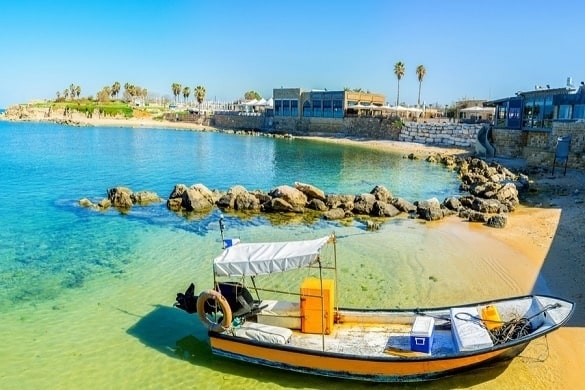
Caesarea, Acre and Rosh Hanikra Tour
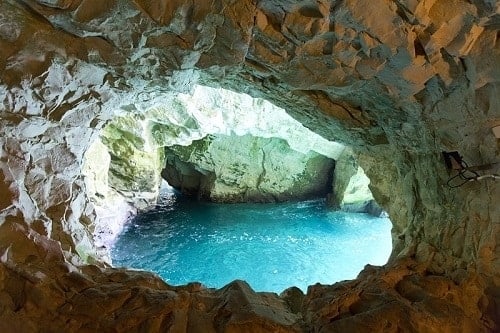
Caesarea, Haifa and Acre Private Tour
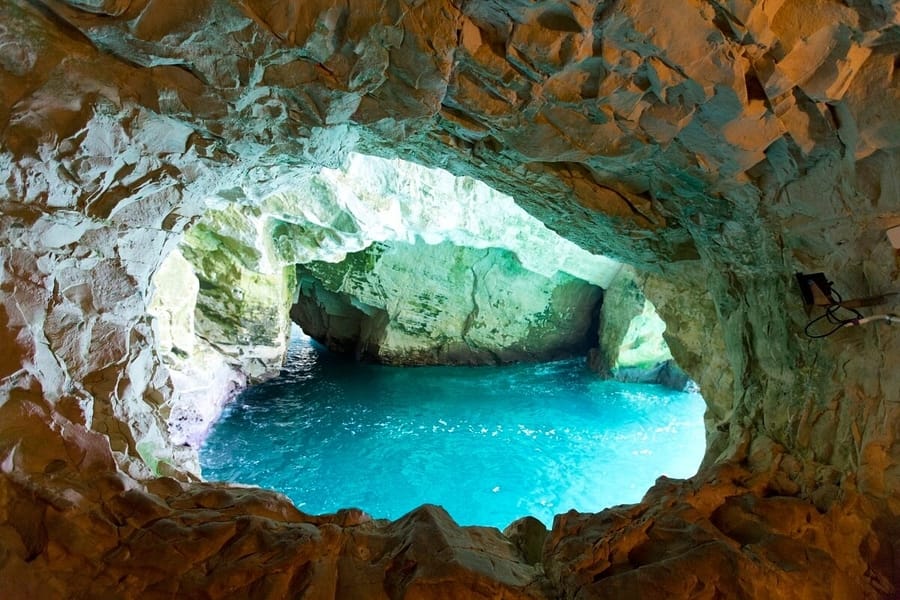
Thank you for subscribing
Keep in Touch

Customer Care
Get to Know Israel
Popular Destinations
Our Services
Rosh Hanikra
Last updated on December 20, 2023.
The grottoes at Rosh Hanikra are one of the most spectacular natural sites in Israel . They’re located at the northwest corner of the country on the border with Lebanon.
We visited Rosh Hanikra on a guided tour from Tel Aviv , including stops at Caesarea , Haifa , and Acre . Rosh Hanikra was easily the highlight of the tour.
- 0.0.1 Visiting
- 0.0.2 Cable Car
- 0.0.3 Railway Tunnel
- 0.0.4 Grottoes
- 1 Share this:
- 2 Like this:
Adult admission to Rosh Hanikra is ₪48, which includes a two-way ride on the cable car. The grottoes are open daily.
The cable car is advertised as the steepest in the world. It runs for 70 meters on a 60º angle. It was built by Doppelmayr/Garaventa Group of Austria. The original plan was for our group to ride the cable car down to the grottoes, but it was extremely crowded on the day we visited.
Railway Tunnel
Instead, our guide took us down to sea level for a different way in. We walked to the grottoes through a historic railway tunnel.
The tunnel was constructed during the British Mandate period as part of the line from Haifa to Beirut and on to Tripoli. It was built to connect Cairo and Istanbul by rail through Egypt , Palestine , Lebanon, Syria, and Turkey .
The railway tunnel was built between 1941 and 1942, and opened to freight service on August 24, 1942. The British had plans to implement passenger service in 1947, but due to the 1948 Arab-Israeli War , this never happened.
Another tunnel on the northern side of the property leads from Israel to Lebanon. A third tunnel entirely in Lebanon is further north.
Once through the tunnel, we could see the lower cable car station and the entrance to the Rosh Hanikra grottoes. The grottoes are naturally formed by the sea crashing against the soft chalk rock, which is visible on the cliffs in the area.
The tunnels were completed in 1968 and run for a total of 200 meters. Visitors can follow the path through the tunnels to see the beautiful grottoes.
Before 1968, the grottoes were only accessible by sea. They were popular with local swimmers and divers, who were the only people able to visit.
At the end of the tunnels, the path continues along the chalk cliffside for views of more beautiful rock formations. Looking north, it’s possible to see the border between Israel and Lebanon.
Share this:
Owner of Paisadventure. World traveler. Chicago sports lover. Living in Colombia.
Related Posts
Umbría valley, leave a reply cancel reply.
This site uses Akismet to reduce spam. Learn how your comment data is processed .
Rosh Hanikra
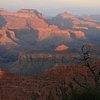
Top ways to experience Rosh Hanikra and nearby attractions

Most Recent: Reviews ordered by most recent publish date in descending order.
Detailed Reviews: Reviews ordered by recency and descriptiveness of user-identified themes such as waiting time, length of visit, general tips, and location information.
Rosh Hanikra - All You Need to Know BEFORE You Go (2024)
- Haifa Acre and Rosh Ha-Nikra Private Tour from Tel Aviv (From AU$1,836.79)
- Haifa, Acre & Rosh Anikra Grottos Haifa Port FullDay Shared Tour (From AU$610.74)
- Full-Day Historical Tour in the Israeli-Lebanese Border (From AU$1,683.74)
- 2024 Israel Christmas Holy Land Tour - Bethlehem Midnight Mass (From AU$3,479.22)
- Shared 9 Days Christian Tour in Tel Aviv and Jerusalem (From AU$3,505.24)
- (1.15 km) Hamakom Suites
- (0.77 km) Rosh Hanikra Holiday Village
- (0.73 km) Nekarot Holiday Village
- (9.09 km) Shtarkman Erna Boutique Hotel
- (12.09 km) Nea Resort & People
- (0.07 km) HaTsuk Restaurant
- (1.17 km) Tosha Bakery
- (3.96 km) Michael Local Bistro
- (9.58 km) Donatella
- (9.61 km) Alexander Local Diner
- (0.02 km) The Grottos at Rosh HaNiqra
- (0.08 km) The Lebanese Border
- (5.74 km) Trek Yam Achziv
- (9.52 km) R.E.J. Tours
- (8.63 km) Adventure Israel - Day Tours
Top Things to Do in Rosh Hanikra, Israel
Places to visit in rosh hanikra, explore popular experiences, archaeology tours.

Full-day Tours

Top Attractions in Rosh Hanikra
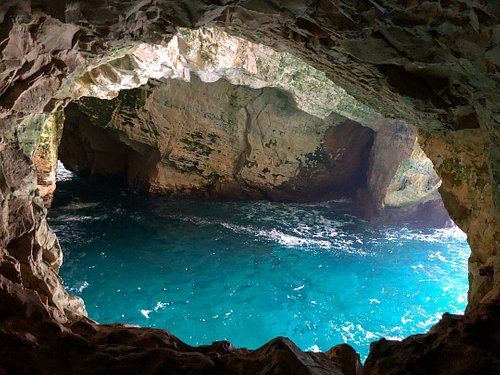
Other Top Attractions around Rosh Hanikra
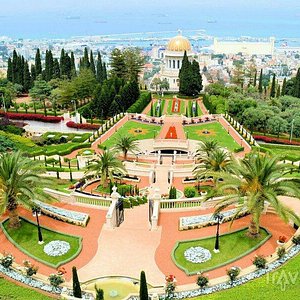
Historical Tours
Cultural tours.

Walking Tours
Private and luxury, multi-day tours.
- Rosh Hanikra
- Caeserea, Rosh Hanikra and Acre Day Trip from Tel Aviv
- Highlights of Caesarea, Haifa, Acre and Rosh Hanikra Tour from Tel Aviv
- Unforgettable Tour to Caesarea, Haifa, Acre and Rosh HaNikra from Tel Aviv
- Caeserea and Rosh Hanikra Day Trip from Jerusalem
- Haifa, Acre & Rosh Anikra Grottos Haifa Port FullDay Shared Tour
Unusual Places
Rosh hanikra: a secluded grotto experience in israel.
If you’re looking for a unique experience combining spectacular natural scenery and a glimpse into ancient history of Israel , you won’t miss a visit to the Rosh HaNikra Grottoes . Located along the Israeli-Lebanese border on the Mediterranean coast, the grottoes offer a secluded journey through a vast network of caves and tunnels carved out of limestone by sea waves. Not only are they a beautiful sight to behold, but they also hold a long and fascinating history that makes them an exceptional destination.

The Rosh HaNikra natural grottoes. Photo by depositphotos.com
The grottoes can be accessed by a cable car, which is a fun and unique way to get there. The descent to the grottoes is thrilling, and you’ll get to take in the breathtaking views of the blue Mediterranean Sea and the white limestone cliffs surrounding the area.
Once you arrive at the bottom, you can explore the numerous caves and crevices carved out by thousands of years of coastal erosion. Many caverns are large enough for boats to enter and explore, allowing visitors to discover their hidden secrets. There are several viewing points around the grottoes where you can observe the stunning formations from above as well as observe the occasional dolphin or seal playing in the crystal clear waters below.

The white chalk cliffs and underground grottoes Rosh Hanikra Photo by depositphotos.com
You don’t have to limit your experience just to what you see on the surface – nearby tour operators offer an array of water activities, including snorkeling, kayaking, and scuba diving, so visitors can go deeper into the depths of this incredible site. For those who enjoy a more relaxed approach, sunbathing is also a popular activity here.

Rosh HaNikra – Israeli National Park Photo by depositphotos.com
After your exploration of the Rosh HaNikra Grottoes is complete, there are plenty of other activities to enjoy in the nearby area. The city of Akko is full of historical sites and cultural attractions to explore, while the ancient ruins of Caesarea and Acre offer a glimpse into the distant past.

Rosh Hanikra Cliff near Israeli- Lebanese Border Photo by depositphotos.com
Whether you choose to stay on the surface or dive deeper into the depths, there’s something for everyone in this unique and beautiful part of the world.
About The Author
Your email address will not be published. Required fields are marked *
Name (required)
Email (required)
Notify me of follow-up comments by email.
Notify me of new posts by email.
THE BEST Things to Do in Rosh Hanikra
Things to do in rosh hanikra, explore popular experiences, archaeology tours.

Full-day Tours

Top Attractions in Rosh Hanikra

Other Top Attractions around Rosh Hanikra

Historical Tours
Cultural tours.

Walking Tours
Private and luxury, multi-day tours.
- Rosh Hanikra
- Caeserea, Rosh Hanikra and Acre Day Trip from Tel Aviv
- Highlights of Caesarea, Haifa, Acre and Rosh Hanikra Tour from Tel Aviv
- Unforgettable Tour to Caesarea, Haifa, Acre and Rosh HaNikra from Tel Aviv
- Caeserea and Rosh Hanikra Day Trip from Jerusalem
- Haifa, Acre & Rosh Anikra Grottos Haifa Port FullDay Shared Tour
You are using an outdated browser. Please upgrade your browser or activate Google Chrome Frame to improve your experience.

- Donate Now!
- Find an Opportunity
- Performance Report
- Board of Governors

- Experience Israel Choose an experience and discover Israel for yourself Machon Youth Leadership ...More Programs >>
- Israel In Your Community Bringing Israel to your schools, community centers and camps Shlichim (Israeli Emissaries) Commitment to Diversity Global School Twinning Network Israel Engagement Catalogue ...More Programs >>
- Jewish Social Action Building a better society in Israel and abroad ...More Programs >>
- Aliyah Thinking of moving to Israel? Here is all the information you need Child Allowance - Kitzbat Yeladim Global Service Center ...More Programs >>
Rosh Hanikra is a chalk cliff on the beach of Upper-Galilee on the border between Israel and Lebanon, chiselled out into labyrinthine grottoes filled with seawater formed by the geological and biological processes and by waves lapping on the soft rock.
History Throughout human history, Rosh Hanikra served as point of passge for trading caravans and armies between Lebanon, Syria - the northern cultures - and Israel, Egypt, Africa - the southern cultures. The Book of Joshua (Ch. 13:6) mentions "Misraphot Mayim" South of Rosh Hanikra, as the border settlement of the Israelite tribes of that period. Jewish sources referred to the cliff as "The Ladder of Tyre" and, as such, it is mentioned for the first time in the Book of Maccabees I, 11:19, Josephus in his book "De Belli Judeorum" (II: 2, 188) mentioned the high ridge "100 stadia from Acre", known by the people the ladder of Tyre. It was also the place ("Sulma deTzor") where Rabban Gamliel descended from his donkey (Eruvin 60, page B). After the Arab Conquest, the site was renamed A-Nawakir (the grottoes). The present name, Rosh Hanikra, is a hebraicized version of the later Arabic variation Ras-A-Nakura. In 701 B.C.E. the army of Sennacherib passed the way between Tyre and the land of Israel. Alexander of Macedonea (323 B.C.E.) is credited for having hewed a tunnel at Rosh Hanikra to create a passageway for his army after besieging Tyre; armies of the Seleucids and the Ptolemies in their wars in the third and second century B.C.E., made use of this road, as did the Crusaders in 1099 C.E. Documents and drawings of pilgrims show stairways carved into the rock, facilitating the passage of caravans. The first road accessible to motor vehicles was cut by the British Army during World War One. At the time of the British Mandate in Palestine, a road was laid for commercial and private use. A border post and customs office were established at the site.

In the past, the only access to them was from the sea and experienced divers were the only ones fortunate enough to visit. The grottoes have a unique aspect at different times of the day. At sunset, in particular, the sea and cavern walls take on a special hue. Seasonal changes also alter the grottoes' appearance dramatically. The polished, silvery mirror-like appearance in summer, transformed into a churning, explosive scene in winter. This rare beauty became accessible to the general public in 1968, when, a tunnel was excavated to the natural grottoes, slightly above the sea surface. It is 400 meters long and took two years to complete.
Geo-Morphological Structure

Ecology The cliff and the sea-shore are a natural reserve of unique fauna and flora. On the slopes of the cliff, amongst Charob and Pistacia Elastica, blown and started by the wind into Bonsai-like shrubs, blooms the Statice, endemic to this stretch of land. The scented white sea-shore Lilies, Narcissus and Squill, bloom in autumn and wintertime. Other colorful flowers bloom in early spring. Inside the Grottoes, groups of bats spend their day resting on the ceiling while swallows and rock pigeons nest in the protective darkness of the caves. flights of seagulls wing their way to their nesting island a mile to the west. There one can observe most of the local and European sea-shore and sea birds. The sea-shore pools offer plenty of food to winter-guest birds. The rocky depths of the sea offers a friendly environment to all kinds of Mediterranean fish and other marine animals. The most attractive guest to this shore is the loggerhead turtle, a huge maritime reptile that has chosen these rocky shores as a mating area, and the rough sand shores to dig his bottle shaped pits where the females lays eggs in early summer. A few weeks later hundreds of tiny turtles dig their way out of the pits and hurry to the sea guided by the beam of the full moon. Today the nesting areas are endangered by the changing environment and by tourism.

We wish to acknowledge our gratitude to the marketing division of Rosh Hanikra for the permission to use text from their folder for this "Live" site page. Additional details are based on the "Guide Israel" and "Israel - Sites and Places".
The pictures were taken by my self, Pinhas Baraq


Hiking the Holyland
Your path to Israel's great outdoors.
Coastal Trail to Rosh HaNikra
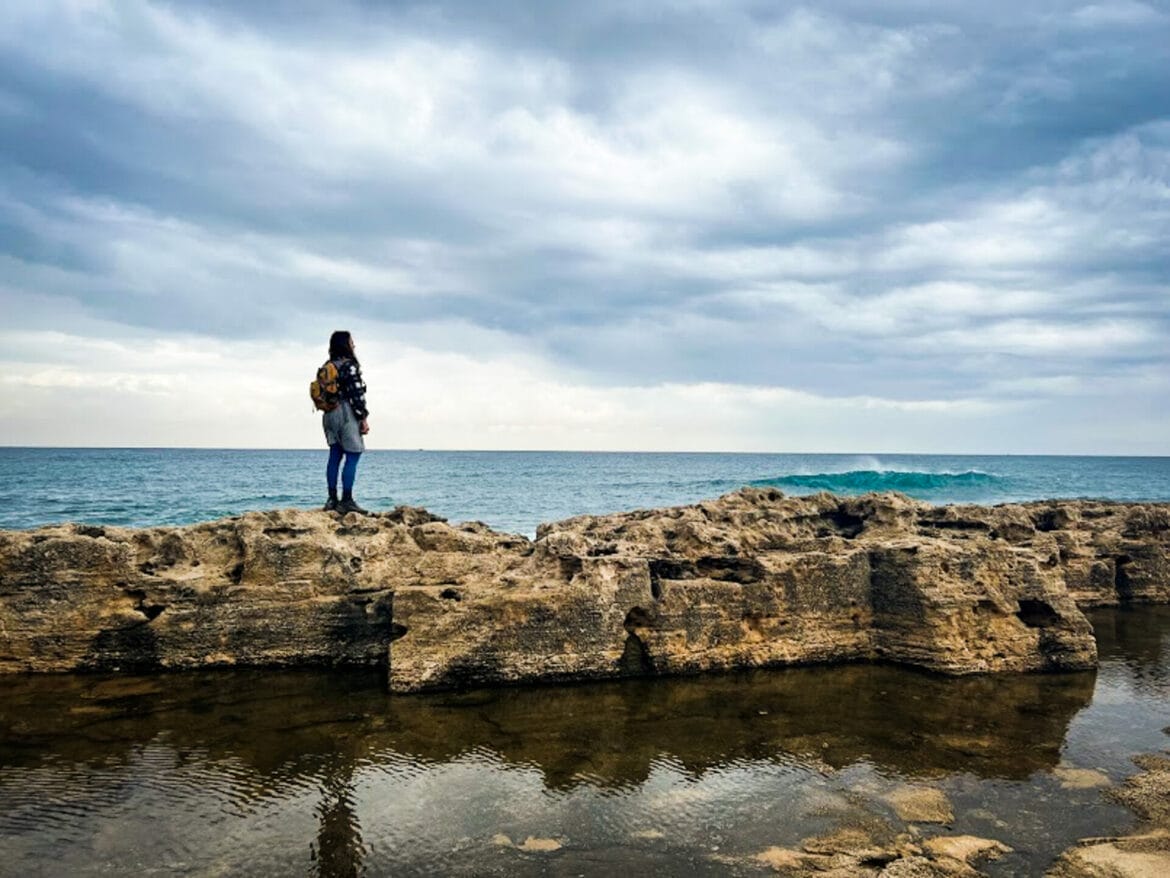
Click here to go straight to hike notes.
The first time I visited Rosh HaNikra I was fifteen years old. I remember being struck by the beauty of the place: the white rock, framing turquoise waters inside the grottoes. It felt like some secret pirate lair, or a mermaid palace.
Since that visit, I’ve been back to Rosh Hanikra many times. Despite the many tourists and the cable cars, it’s still one of my favorite attractions in Israel. And on one visit a few years back, while we were gazing out at the islands off the coast, we noticed a trail that followed the shoreline towards Achziv. At the time, we made plans to return to Rosh Hanikra and follow that trail.
Last week, we did just that. On an overcast and drizzly morning, we made the two and a half hour drive to Achziv National Park where we began our day. Then, we hiked up the coastline, exploring tidal pools and rocky crevices as we followed the trail all the way up to Rosh Hanikra. The sky was filled with dramatic grey clouds, and the area beyond the coast was green and flower filled. Just as in the Rosh Hanikra grottoes, the sea was a deep turquoise blue. It was a wonderful morning.

Here’s how we hiked this 7 kilometer, one way coastal hike from Achziv National Park to Rosh Hanikra:
Where to Begin?
After a few failed beginnings (at the Achziv neighborhood of Nahariya, and then at the Achziv National Park), we found the beginning of the trail just outside of the popular Achziv national park and campground. Once we set out on the trail, we were now officially in the Rosh Hanikra – Achziv Marine Nature Reserve.
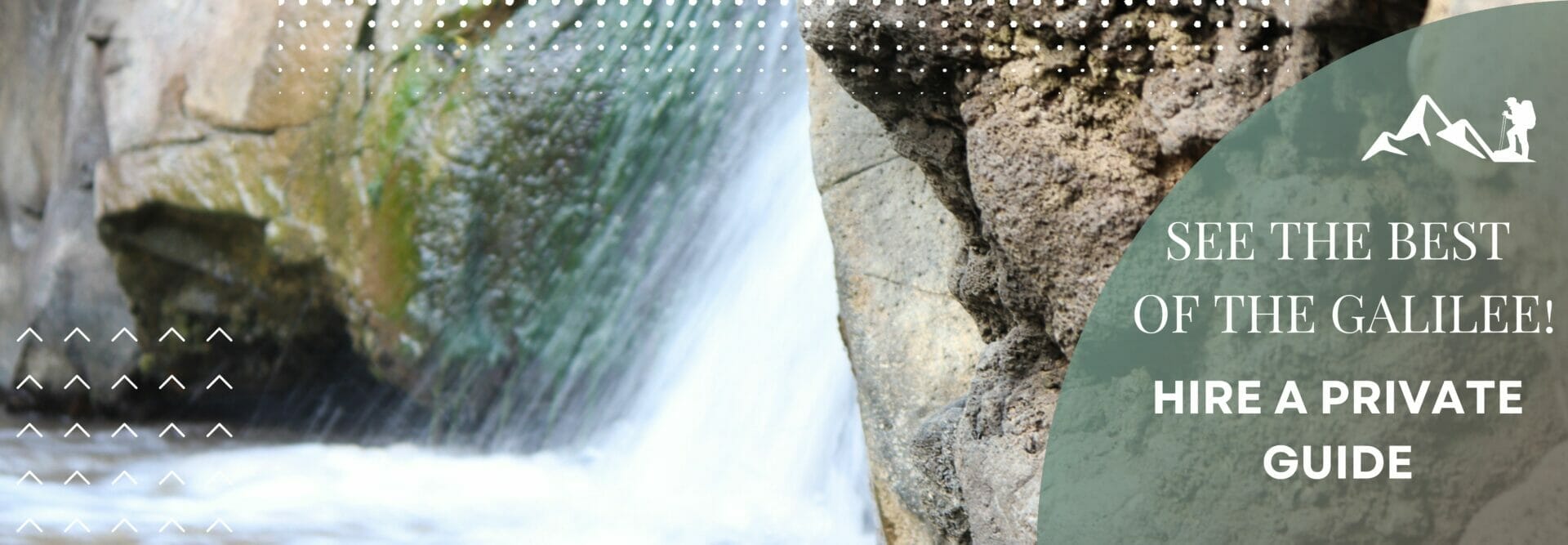
To one side, we could see forests and fields, to the other the coast. This was the exact spot where we began our Yam el Yam hike a couple of years ago, the trail that leads from the Mediterranean Sea to the Sea of Galilee. We strapped on our backpacks and began walking.

Our first stop was a memorial to the Ma’apilim, the Jews who bypassed the British during mandate times to immigrate to Palestine. It seemed to be in disrepair, but we enjoyed reading about it online , where it said that it was built from pieces of the ships that they used to reach Israel.
Next, we followed the asphalt paved path along a beautiful coastline. It was cold outside, and a little bit rainy. Our goal was to warm up our blood with some fast walking and get away from the highway noise as quickly as we could.
We’re There!
Pretty soon, the traffic noise disappeared, to be replaced by the overpowering sound of crashing waves. Having just spent a summer at Acadia National Park in Maine, I was reminded of the coastal hikes there. In Maine, there’s a place called Thunder Hole, where crashing waves sound like thunder on the shore. Tourists flock to the spot.
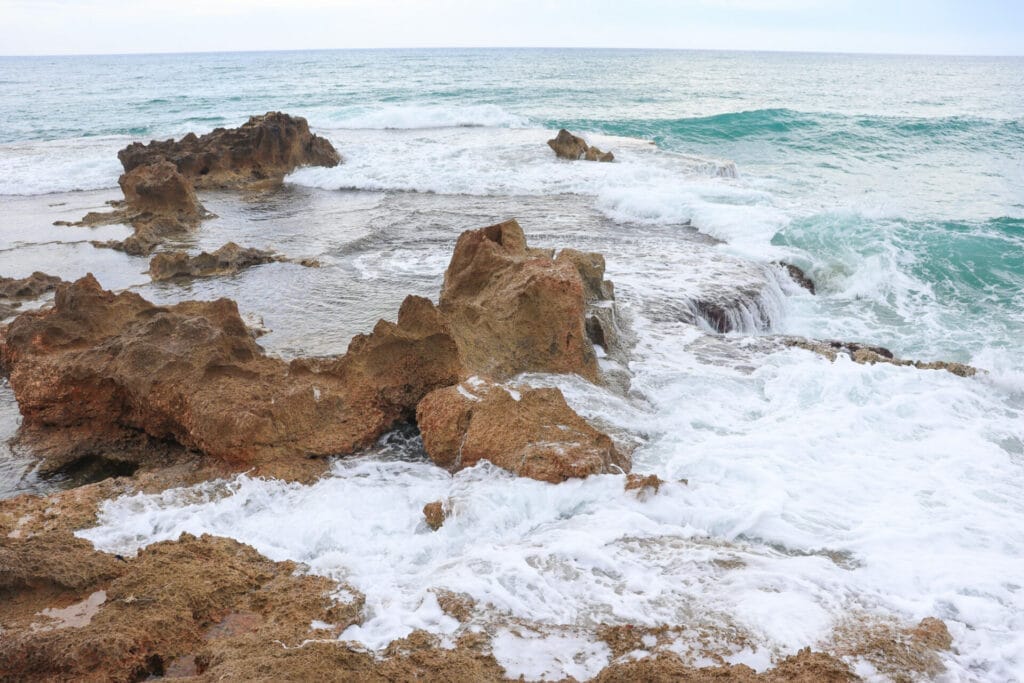
On this coastline in Northern Israel, we had our very own thunder hole all to ourselves. Watching the waves crash against the rocky shoreline, we knew that we had found our morning coffee spot.
Breakfast and More
We sat down on the dry rocks, just above the crashing waves. It was chilly out there, and I was eagerly looking forward to a hot cup of coffee poured from our thermos. Soon, coffee in hand, we were free to enjoy the magnificent show of the waxing and waning waves. Strawberry overnight oats were the perfect accompaniment to the magnificent views.
In the shadows of a jagged rock, I noticed two smooth red bumps. After we finished eating, I crept down to try to touch them, making every effort to avoid the crashing waves that drenched the inside of the rock every few seconds. I didn’t stay completely dry, but I did discover that the red bumps were smooth and soft and planted firmly into the rock. They seemed sort of like snails without a shell.
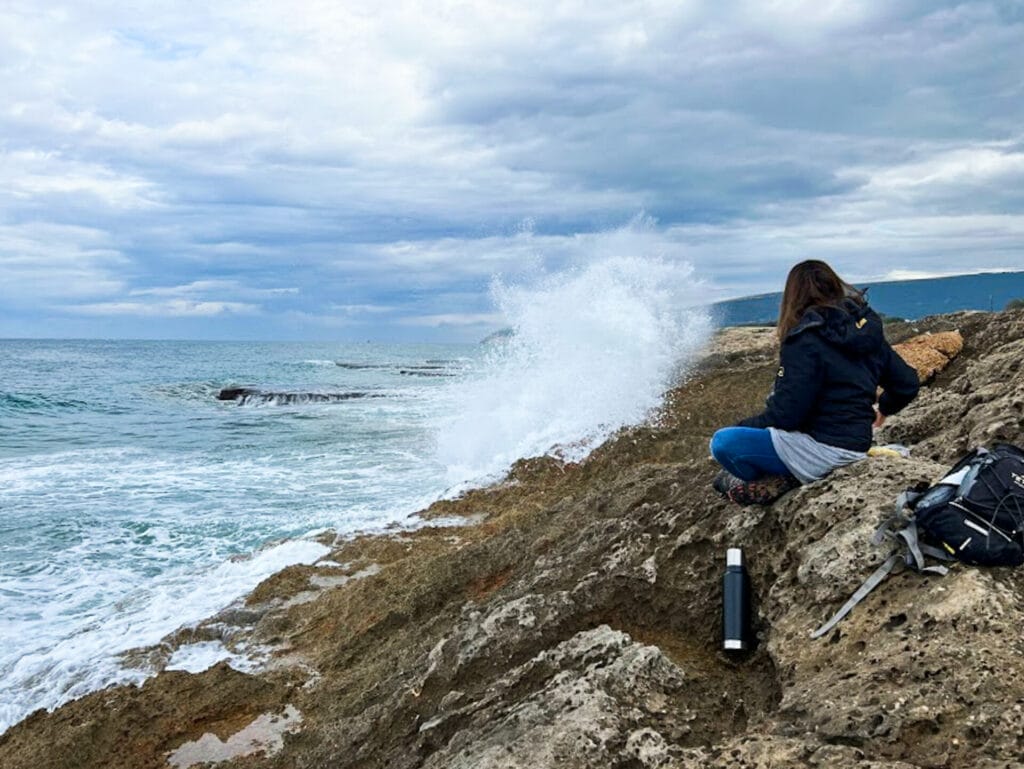
I moved to another spot to take pictures of the waves crashing into the shore. It was then that a massive wave overtook me on my precarious spot on the rocks, drenching me completely. First I had to get over my shock, then I strapped on my backpack and got ready to move. It was time to keep going.

Luckily, this was an easy walking trail – it wasn’t difficult to hike quickly and warm up. As we climbed over rocks and took in the scenery, I dried off bit by bit.
What most impressed me about this area was the quiet. We felt fully immersed in nature. This is rare for coastal trails. At the Rosh Hanikra-Achziv Marine Nature Reserve, it really felt like we were in a nature reserve , not some urban coastal trail with a pretty shoreline.

We passed by low walls of rock, and little tidal pools, each one full of marine life. This too reminded me of Acadia, where we picked up starfish in tiny pools off the sea.
After a few kilometers of beautiful walking, we found ourselves at the foot of Rosh Hanikra. Here, we crept into our own private “water cave” – a little inlet of turquoise water flowed in and out of dark grey rock.
To Rosh HaNikra
Our plan was to climb up to Rosh Hanikra and visit the grottoes. But when we reached the top, we encountered a massive group of young tourists. There was no way we were going to get a cable car any time soon – and even if we did, it probably wouldn’t have been a very serene experience to visit the grottoes with a loud and boisterous group. So, we left the grottoes for next time and called a cab to get back to our car.
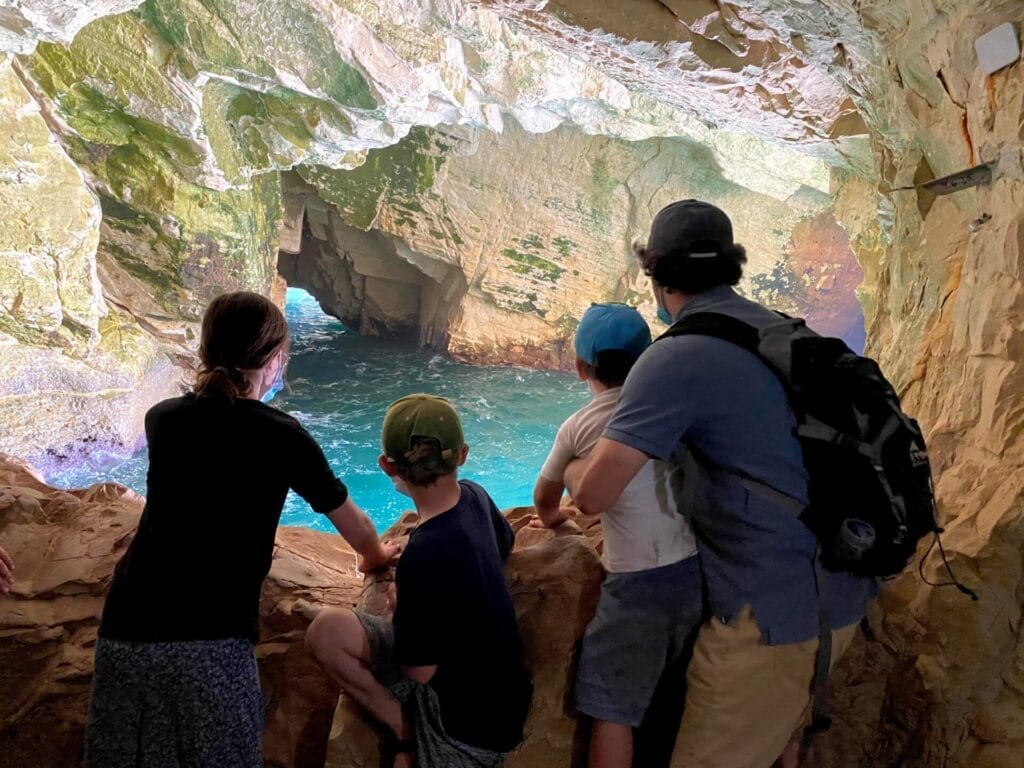
A short ride later, we were back at the trailhead. Before heading off to complete our errands in the north, we made one final stop at the Achziv National Park right nearby. We wanted to see the historical artifacts at the site.
Turns out, Achziv National Park is more of a beautiful picnic area and campground than anything else. There are historical buildings at the site – from Ottoman and Roman periods – but there were no signs or anything else to explain what we were seeing. We spoke to a chilled out ranger who basically said, “There are some old buildings here – and a really nice place to have a picnic!”

It was quite pretty. And as we walked away from the well-kept grounds of Achziv National Park we got our final treat of the day: a group of five hoopoes, Israel’s national bird, busily plucking worms from the rain moistened grass. They were so busy with their hunting that they allowed us to get quite close to observe.
It had been a fantastic morning, full of so many beautiful rainy-day sights and sounds on the coast. This gorgeous hike from Achziv to Rosh Hanikra is a spectacular excursion into the nature of the Mediterranean coastline.

Hikers’ Notes:
Here’s what you need to know to hike this trail from Achziv to Rosh HaNikra:
- This is a one way trail.
- Great for kids.
- Suitable for dogs (except Rosh HaNikra).
- This is an all season trail.
- To enter the National Park at the beginning of the trail (optional) or the Rosh Hanikra grottoes at the end (optional), you will have to pay an entrance fee. There are bathrooms and a store in both places. Otherwise, this is a free entry trail.
- To follow the trail: Just walk along the coast, either on the path or on the rocks, until you reach the blue trail at the bottom of Rosh Hanikra.(The blue trail is not pictured on the trail map.) From there, follow the blue trail to the top of Rosh Hanikra, at the entrance to the cable car site.
- To get back to the trailhead: it's a short cab ride away, which costs about 50 NIS. (Achziv Cab: 052-372-5726)
Don’t forget to read my guide to the navigational features in this post before you hit the trail!
Trail map from Amud Anan .
Questions? Have you hiked this trail from Achziv to Rosh HaNikra? Let’s hear about it in the comments!

Hiking can be dangerous and is done entirely at your own risk. Information is provided free of charge; it is each hiker’s responsibility to check it and navigate using a map and compass.
More to explore:.

1 thought on “ Coastal Trail to Rosh HaNikra ”
Summer 2022 we camped at Achziv Beach (lagoons great for younger kids) and from the outside of the campground walked to Rosh Hanikra. There is a paved road, much including a sidewalk, with only the occasional car (Rt. 4 is to the West, usually out of ear-shot). The sea is a few to tens of meters to the East, in view the entire time, with easy access whenever you want from the road to beaches, etc. The steep blue trail that Susannah mentioned starts at a break in the wall on the East side of the road. We were originally planning to walk back, but as it was a hot day, we used our Rav Kav cards and took the bus back! (Thanks for the cab info in the writeup – details like that can really ease logistics.)
Leave a Reply Cancel reply
Your email address will not be published. Required fields are marked *
Cancellation and Return Policy - Terms and Conditions - Privacy Policy

COMMENTS
Combined ticket for a child: a visit to Rosh Hanikra + a visit to Jump Island, Lake Monfort, Maalot. 74 NIS . Get Tickets. Site Tickets: Meet our Flagship attration - The Grottos. The fascinating tourist attraction of Rosh Hanikra is located at the most north-western corner of Israel, the only point in the country where the sea meets the ...
Rosh Hanikra is an incredible geological creation at the farthest point north on Israel's Mediterranean Coastline in the Western Galilee region. The grottoes and caves at Rosh Hanikra are the results of thousands of years of the power of the sea, and after a short yet exhilarating cable car ride down the cliff face, visitors can explore these incredible formations for themselves, following ...
Entrance Fee. The entrance fee to Rosh HaNikra is 48 NIS ($15), and we found the single ticket price on the higher side, at least to some other top attractions in Israel. Rosh HaNikra ticket is separate from Israel Passand includes cable car roundtrip, the grottoes, and a light and sound show.
Rosh HaNikra is located on the northern Israeli border. Getting down (and up) to the caves is via a very short (and steep) cable car ride. The Grottoes are amazing, especially when there are high waves. ... Then after 10 minutes of visit when you finally decide to get out and spend your day to do something nice, you realise you have to queue ...
Tips for Visiting the Rosh Hanikra Grottoes. Visiting the Rosh Hanikra Grottoes can be a memorable experience, and here are some tips to make the most out of your visit: Plan your visit: Check the official website for information on opening hours, ticket prices, and other important details.
Rosh HaNikra Grottoes. Top choice in North Coast. Bone-white limestone cliffs seem to burst from the deep blue sea at this geological beauty spot straddling the Israel-Lebanon border. A cable car descends steeply to the bottom, a journey of barely a minute; from here visitors step into wave-sculpted cave mouths, listening to water mercilessly ...
Child (3 - 18) and pensioner - 39 NIS. Babies and toddlers (0 - 3) - free. Audio guide rental - 14 NIS. There are several types of combined tickets. The first type offers a visit to Rosh HaNikra Grottoes and a bicycle or a golf car drive along the beach. It costs 77 NIS per adult and 69 NIS per child.
The combined ticket allows you to enjoy a visit to the Rosh Hanikra tourist site, including going down and up in the cable car, an independent tour of the grottoes and watching a video, and then continue independently to Old Acre and visit the Knights' Halls, the Templars' Tunnel, the Okashi Museum, the Museum of Treasures in the Wall and the Turkish bath-house, all for a discounted price.
The Rosh HaNikra cable car is a cable car serving tourists wishing to visit the grottoes. The cable car is situated very close to the Lebanese border. The site is popular with tourists, and is one of the facilities available for tourists in Kibbutz Rosh HaNikra .
The Basics. When visiting Rosh Hanikra, you can ride a cable car down the cliffs and explore the networks of caves and grottoes on foot. There is also hiking and bike riding along the seafront promenade, and panoramic views of the Mediterranean from atop the cliffs. A number of full-day tours of Rosh Hanikra depart from from Tel Aviv.
Want to visit Rosh Hanikra? Join our Caesarea, Acre, and Rosh Hanikra Tour. Practical Details Where: Rosh Hanikra is at the northern end of highway route #4; 10-minute drive north of Nahariya. Open Hours: the caves and cable car of Rosh Hanikra are open Sunday to Thursday and Saturday 9 am-6 pm as well as Friday 9 am to 4 pm. In very bad ...
Discover Rosh HaNikra Grottoes in Acre, Israel: The bluer than blue waters in these natural Israeli caves are reached via the world's steepest cable car. ... Visit Adventures. Trips Highlight.
Things to Do in Rosh Hanikra, Israel: See Tripadvisor's 606 traveler reviews and photos of Rosh Hanikra tourist attractions. Find what to do today, this weekend, or in April. We have reviews of the best places to see in Rosh Hanikra. Visit top-rated & must-see attractions.
15. Caesarea, Haifa, Rosh Hanikra, and Acre Tour from Jerusalem. 7. Historical Tours. 6+ hours. Explore the highlights of Israel's northern coast, from the ancient Roman ruins at Caesarea to Haifa's Bahai sites, a crusader…. Free cancellation. from. $172.
Rosh Hanikra grottoes Rosh Hanikra grottoes Tunnel to the grottoes. Before 1968, the grottoes were only accessible by sea. They were popular with local swimmers and divers, who were the only people able to visit. "Window" in the grottoes Rosh Hanikra grottoes Near the end of the tunnel
Top ways to experience Rosh Hanikra and nearby attractions. Haifa Acre and Rosh Ha-Nikra Private Tour from Tel Aviv. 3. Full-day Tours. from. AU$1,430.71. per group (up to 4) Caeserea, Rosh Hanikra and Acre Day Trip from Tel Aviv. 187.
Rosh Hanikra is a popular tourist attraction located at the most north-western corner of Israel, the only point in the country where the sea meets the mountains. ... Visiting the tourist site at Rosh HaNikra - Length of the visit is around an hour and a half The ticket includes: Descending by cable car, watching the light-sound show, visiting ...
Highlights of Caesarea, Haifa, Acre and Rosh Hanikra Tour from Tel Aviv. 2. Historical Tours. from. ₹12,652. per adult. Full-Day Private Tour Along the Northern Shores of the Holy Land.
If you're looking for a unique experience combining spectacular natural scenery and a glimpse into ancient history of Israel, you won't miss a visit to the Rosh HaNikra Grottoes.Located along the Israeli-Lebanese border on the Mediterranean coast, the grottoes offer a secluded journey through a vast network of caves and tunnels carved out of limestone by sea waves.
Reserving your visit through the reservation system ensures a spot on the date and time you've requested; you'll also receive relevant updates for your planned visit. ... Rosh Hanikra Beach Nature Reserve - a declared nature reserve. The nature reserve covers an area of 230 dunams, and is 2300 m long and 100 m wide, from the shore to the ...
Top Things to Do in Rosh Hanikra, Israel: See Tripadvisor's 606 traveller reviews and photos of Rosh Hanikra tourist attractions. Find what to do today, this weekend, or in January. We have reviews of the best places to see in Rosh Hanikra. Visit top-rated & must-see attractions.
The present name, Rosh Hanikra, is a hebraicized version of the later Arabic variation Ras-A-Nakura. In 701 B.C.E. the army of Sennacherib passed the way between Tyre and the land of Israel. Alexander of Macedonea (323 B.C.E.) is credited for having hewed a tunnel at Rosh Hanikra to create a passageway for his army after besieging Tyre; armies ...
To Rosh HaNikra. Our plan was to climb up to Rosh Hanikra and visit the grottoes. But when we reached the top, we encountered a massive group of young tourists. There was no way we were going to get a cable car any time soon - and even if we did, it probably wouldn't have been a very serene experience to visit the grottoes with a loud and ...
Regrettably, we are currently not conducting trips to Caesarea, Acre, and Rosh Hanikra due to security concerns in northern Israel. Best regards, Bein Harim tours "If your tour is cancelled you can easily visit Akko and Haifa by train ( not on Shabbat)